Blog > The 10 best PowerPoint Games to play in Workshops, Classrooms & Presentations

The 10 best PowerPoint Games to play in Workshops, Classrooms & Presentations
01.01.20 • #fun #game #powerpoint #presentation.
In our last blog post, we talked about tools and tips on how to boost the audience engagement in your presentation. One of our recommended ways to do so was to play games, as they release tension and function as a fun element that lightens the mood. That’s why today we are going to list the Top 10 best games to play in your presentation.
1. Would you rather
Is it a game that everyone knows already? Probably. But did we have to include it on the list because it is just perfect for playing with your audience? Definitely. The game is pretty much self-explanatory – You give your attendees two (or more) scenarios and they have to choose which one they’d rather experience. Combining the Would you rather – question with your presentation topic is usually very easy, but we also thought of some questions you could use for any topic (e.g. as an icebreaker, to get to know your audience a little better, to ask about their opinion or just as a fun element in between). You can let your audience vote by letting them raise their hands or by using an interactive poll tool such as SlideLizard .
- Would you rather A. travel back in time OR B. travel to the future OR C. stay in the present
- Would you rather A. have a long lunch break now OR B. have a short break and finish early
- Would you rather A. be able to read minds OR B. be able to fly OR C. be able to turn invisible
- Would you rather A. receive a letter from Hogwarts OR B. join Frodo on his journey OR C. Hog-what?
- Would you rather A. never be able to go on Social Media again B. never be able to read a book again

2. Charades
The popular game is not only great for your family’s game-night, but also for your presentations and workshops. Prepare a few cards that have words related to your presentation’s topic on them, let some volunteers in your audience draw and act them out. The rest of the audience has to guess the word. You can be sure that these terms and the associated performances will never be forgotten!

Small Trivia quizzes are perfect for checking and manifesting the audience’s knowledge at the end of your presentation. Instead of repeating and summing up what you have already said, you can let your participants test their knowledge right away. However, you can also use a quiz in the beginning to test your audience’s existing knowledge about a topic. But there are not only trivia quizzes: Questions about personality can also be interesting and work well as an ice breaker in the beginning. Again, we recommend a tool for poll creation, as that is the easiest way to conduct quizzes. In a recent article we listed 50 great questions (a mix of personality and trivia) , that you could use for your next presentation! And if you're a fan of quiz game shows, we also got a full Who wants to be a Millionaire PowerPoint template for you to download for free! You'll see how it looks like in the following video (be sure to turn up your sound!):
PowerPoint can be used for way more than most people know. Even we were amazed by people on the internet who created extensive games by animating content using PP. We don’t want to go that big today, but we are going to provide you with a free-to-download template of memory. You only have to add it to your presentation and customize the pictures or terms you want under the cards. Download free PPT Memory Template
5. Two Truths and a Lie
Here is another game that is just perfect when you play it with interactive poll tools. It is great for getting the audience to know you as a presenter better. Think of a fun, interesting or astonishing fact about yourself, and then invent two fake ones. Your attendees have to vote which statement they think is true. Be prepared to see some very surprised faces in your audience!

6. PowerPoint Karaoke
PowerPoint-Karaoke is the perfect improvisation game. Players are confronted with a set of slides they have never seen before and try to give a presentation as convincingly as possible. If you want to know all about this game and get some slides you can use for playing, check out our detailed blog post on PowerPoint-Karaoke .

7. Where do you stand?
For the game “Where do you stand?”, your attendees will actually have to stand up. Therefore, it is only convenient if you have enough space. If you want to get your participant’s opinion about something and get them to move a little, look no further! Create an imaginary line across the room. One end stands for one opinion, the other end for the exact opposite opinion. Your attendees can now place themselves on this line wherever they like (right in the middle, on either end or somewhere in between). You can then even interview people on the line (it is always interesting to choose two from opposite sites) and learn about their views. If you’re a little overwhelmed now, here are some examples you could use for this game:
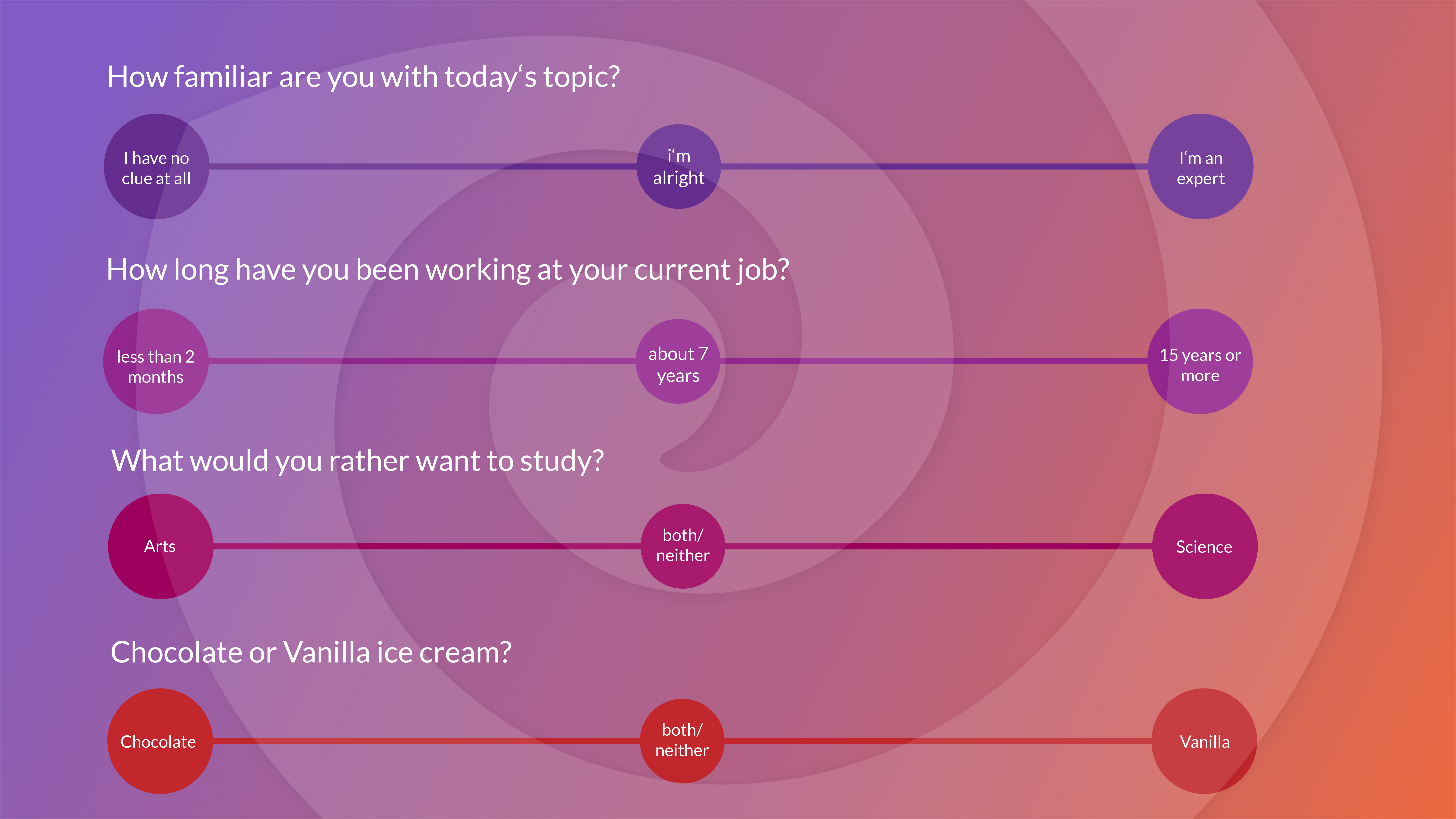
Attention – you can of course ask about political or more controversial topics, but that may escalate and turn into a fight, which is not the purpose of the game or your presentation.
8. Describe That
Let your audience draw from cards with words on them and then describe it for the other attendees. It is basically like charades, but with words instead of acting. Some may find that too easy. In that case, you can either choose terms that are extremely hard to describe or add some “Taboo-words” to the card that can’t be used for describing.

9. True and False
Have you ever heard a crazy, bizarre fact where you didn’t think that it could be true? Perfect. You can use it in the well-known “True and False”-Game. You pick out a fact (ideally something related to your presentation topic) and then let your audience vote (you know – via an interactive poll tool like SlideLizard ) if they think it’s true or not. A tip for making statements false: Change little things about the them, like numbers, dates or names or use common misconceptions and see how many of your attendees buy into them, e.g. “Bulls are enraged by the color red” (which is false, bulls are simply enraged by movement, not specific colors).

10. The never-ending sentence
The never-ending sentence is a great game that incorporates many of your attendees and awakens their brain cells. It is perfect for keeping up their engagement and interest, especially for long presentations or workshops when you feel like some people are getting a little tired. Simply start by saying a word – it can be related to the presentation’s topic if you want – and ask a person in your audience to repeat that word and add another one – the next person to repeat those two words and add another one as well , and so on, until a sentence forms. As it gets longer the game gets a lot more difficult, because there is a lot more to remember and to repeat. The sentence can’t be ended, it has to be continued until someone makes a mistake (or until the last person in the room has added a new word). We promise that you will be left with a lot of fun, creative, and straight-up weird sentences that will make your audience laugh a lot.

Related articles
About the author.

Pia Lehner-Mittermaier
Pia works in Marketing as a graphic designer and writer at SlideLizard. She uses her vivid imagination and creativity to produce good content.

Get 1 Month for free!
Do you want to make your presentations more interactive.
With SlideLizard you can engage your audience with live polls, questions and feedback . Directly within your PowerPoint Presentation. Learn more

Top blog articles More posts
Best Sources for free Icons to use in PowerPoint Presentations

How to highlight image area in PowerPoint

Get started with Live Polls, Q&A and slides
for your PowerPoint Presentations
The big SlideLizard presentation glossary
Visual communication.
If there are used images or videos for communication, it is visual communication. Visual Communication is almost used everywhere like on television, posts on social media (Instagram, Facebook), advertisement.
.odp file extension
.odp files are similar to .ppt files. It's a presentation which was created with Impress and contains slides with images, texts, effects and media.
Vocalized pause
A vocalized pause means the pause when the silence between words is filled by the speaker with vocalizations like "um", "uh" and "er".
Student Response System (SRS)
With Student Response Systems (SRS) it is possible to get live student feedback in the classroom. Questions and answers can usually be asked and given anonymously, which increases participation and engagement. An SRS may be used for any grade, including university.
Be the first to know!
The latest SlideLizard news, articles, and resources, sent straight to your inbox.
- or follow us on -
We use cookies to personalize content and analyze traffic to our website. You can choose to accept only cookies that are necessary for the website to function or to also allow tracking cookies. For more information, please see our privacy policy .
Cookie Settings
Necessary cookies are required for the proper functioning of the website. These cookies ensure basic functionalities and security features of the website.
Analytical cookies are used to understand how visitors interact with the website. These cookies help provide information about the number of visitors, etc.

20 Interactive Presentation Games
- Employee Engagement , Event Planning , Leadership Techniques

Meetings and conferences can be painfully tedious and dull. So much so that the phrase “Death by PowerPoint” has made it into our lexicon. According to Thomas Sowell , an American political economist and commentator, “People who enjoy meetings should not be in charge of anything.”
But if the problem with meetings is that they tend to be boring, the solution lies in finding ways to better engage and entertain your audience. You probably know the feeling of sitting in a meeting, trying to pay attention while one person drones on for an hour.
Even if the purpose of the meeting is to train, disseminate new developments, or even get everyone up to speed on weekly goals, engaging your audience creates a motivation to pay attention.
That’s why interactive presentation games are a great way to re-energizing meetings by involving audiences in the presentation. Interactive presentation turn passive listeners into active participants. Games allow the attendees to learn new skills, think of solutions within a short time period, and solve problems together.
MeetingPulse equips your team with the tools and resources to create engaging events. With that in mind, here’s our guide to a few popular interactive presentation games.
Related: Creating a Positive Organizational Culture while working remote
1. Project Jeopardy

This game is designed to make the presentation of reports more fun and interactive. The lead person on the report creates cards that have answers from the report.
For example, the card reads “25%.” The rest of the team is supposed to ask the correct question corresponding to the “25%” answer on the card. The question could be something like, “What was the company revenue growth for the quarter?”
How to play: Give everyone the URL to your MeetingPulse meeting. Display the question on your screen and create multiple choice answers or leave it open-ended. The answers will pop up on the administrator’s screen in real-time, and you can share the answers to see how many people got it right.
2. Idea Box Game
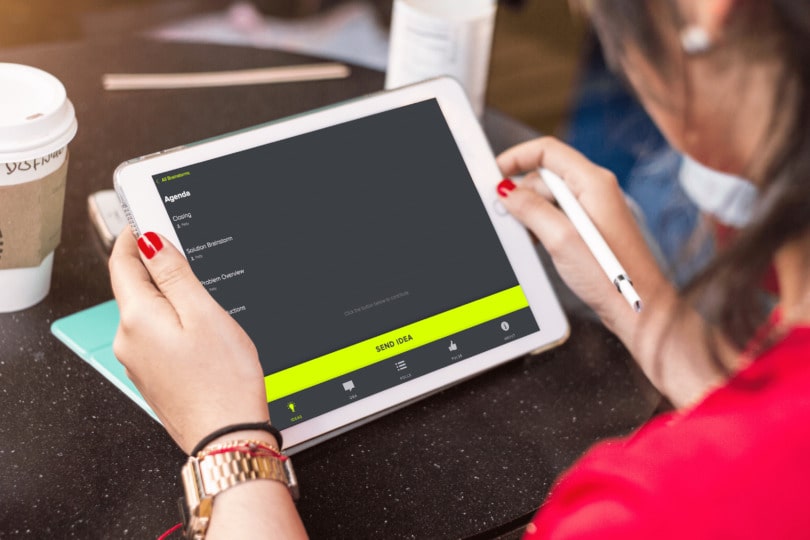
The Idea Box game is excellent for brainstorming meetings where employees can share ideas about a project or product . It helps get the creative juices flowing and might even lead to some usable prototypes. Instead of having one speaker after another speak about their idea, having a team create an idea box creates a space for collaboration to further spark innovation.
How to play: Use the MeetingPulse brainstorming tool to have teams vote and collect feedback about the products. Have each attendee log in to your MeetingPulse link — a virtual Idea Box. Give small groups thirty minutes to brainstorm, then allow submissions.
At the end of the exercise, each team should have the product name, features and functions, marketing taglines, and other vital product details.
Once each team has completed their box they’re invited to share it with the rest of the team who finally vote for the best box. Their ideas will appear on the screen right away, and participants can upvote or downvote in Reddit-style fashion and even submit emoji reactions.
3. The Introduction Game

This game is ideal for a new group of team members meeting for the first time on a mutual project or new hires joining a team. Give the new hires a chance to introduce themselves in an unforgettable manner.
How to play: Ask the new members to bring a personal item or a favorite song. During the meeting, introduce them by letting their song blare for a few minutes on the sound system and then ask them to say something about themselves. If you’re using the personal item, ask them to talk about the item and what it means to them.
4. The talking stick

This activity makes sure that anyone who has a contribution not only gets to do so, but also that they get to speak uninterrupted. Using the talking stick is a great, rapid-fire way to focus the meeting on deep and meaningful contributions.
How to play: Form a circle and make sure everyone’s seated. Before the discussion begins, everyone should agree that the moderator has the power to choose whoever speaks next. Once a member finishes talking, they should put the stick back in the center for the next person.
Use the MeetingPulse audience feedback capability to gain insight right away. Choose up to four emojis and allow your audience to react as they listen to new ideas.
5. Telephone game

The telephone game is used typically as an ice breaker or to liven up a group after a couple of mind-numbing presentations. While it doesn’t really work with a very large group, a sizable number like 10 to 15 people is just right.
How to play: The meeting leader whispers the latest company marketing strategy used to the person on their left who is then supposed to relay the message to the next person and on and on until the last person gets the message.
The last person then gets to tell the rest of the team the final message, and you can compare it to the primary message from the lead.
6. The trivia competition

You can use this game to test the attendees’ trivia knowledge of the company or of general business trends . Create a trivia competition where the members play for points and the winner gets a prize. Project the points for everyone to see the winner.
How to play: Formulate questions related to the company and use them for the trivia test. You can use MeetingPulse to create the questions with its live Q&A session software platform capabilities , and set the timer to begin the game together. To add an extra touch of fun, include images with your multiple choice questions. Visuals add to the level of engagement and give your meetings an extra edge.

7. Fill in the phrase

Check out Meeting Pulse for Cool and creative ways to make polling questions and Quizzes!
This game requires participants to fill in blanks on a survey or report. The survey or report should not be complete until the end of the presentation. This game rewards audiences for listening, and you can even provide some sort of prize.
How to play: Create a report for attendees that has blanks. As you continue with the presentation, invite them to fill in the blanks from the information you are giving. Not only does the audience remain engaged, but they retain crucial information better.
MeetingPulse integrates with Powerpoints , so you can use our single answer polling feature to play this game and display the results directly in your PowerPoint presentation.
8. Word of the day

Have a word of the day game as part of your presentation or meeting. It can be a phrase or a word.
How to play: The presenter should weave the word or phrase into their presentation and the audience acknowledges its use by shouting back. The word must come from the team and not the presenter. This activity keeps everyone alert. Sometimes shouting can be distracting in the middle of a meeting.
In this case, use the MeetingPulse emoji feature, and everyone can submit ? when you use the word “key learnings.”
9. The 20 questions game

You get 20 questions to help you identify a picture that you can’t see, but the audience can. The audience can only lead you with yes or no questions. Use this game to liven up the audience.
How to play: The audience will choose a picture that you can’t see. Have someone submit a photo and display it on the MeetingPulse user dashboard. Get blindfolded and begin to ask questions regarding the picture. You get only twenty questions to get it right.
If you’re an advertising agency, you can use this test your employees’ memory and see if they remember what you worked on. To keep track of all the questions and responses, have the audience choose “yes” or “no” by using a live audience polling tool instead of having them shout it out.
10. Call and response

This game keeps the audience focused. The leader in the meeting calls out a phrase randomly during their presentation and the audience responds to it .
How to play: Agree on the action to be taken every time the phrase is called out. The second the presenter calls out the word, your audience can dance, clap or just rise and seat. Alternatively, they can respond with a phrase, word, or an emoji using MeetingPulse.
11. What would I have done?
In this game, ask each member of the team what their alternative career would be. The point of the game is to open up to each other and foster conversation.
How to play: Each member writes down their alternative career and waits their turn to reveal. The audience collectively asks “What would you have done?” and the selected member responds explaining why they chose that alternative. This is another great game you can play virtually, especially if you’re working with a big team.
With MeetingPulse , you can find out everyone’s alternative career and even get some statistics.
12. Fabulous flags

In this game , team members draw things that matter to them on their flag. This is known as the personal flag game, and it’s an excellent ice breaker activity.
How to play: Everyone gets 10 minutes to draw objects or symbols that represent something meaningful in their lives. Each person gets two minutes to explain the items on their flag.

13. Botticelli

Similar to 20 questions, this game also tests your trivia. You keep in mind a person, place, or thing, and the audience has to guess. The game is a bit more complex because the player can talk back to the audience and distract them from the name.
How to play: The audience asks leading questions to which the player responds with a yes or no. If they ask a specific question like “Does the celebrity’s name start with B?” then the player can respond with “It’s not Brad Pitt.”
This game is logistically easy to plan because all you need to do is formulate the poll questions and integrate them into your PowerPoint with MeetingPulse .
14. Candy introductions

This is a game that allows people to get to know each other while enjoying some sweet treats. It’s excellent for training sessions where participants are complete strangers, providing general topics for introductions that employees can elaborate upon further.
How to play: The participants choose different types of candy from a bag and use each to represent different topics about themselves during the introduction. They can talk about family, career, hobbies, unexpected characteristic and dream destinations.
15. Crazy job interview

In this game, one participant tries to convince the others why they would be the best for a certain job. They have to expound on qualities given by another player and how those qualities make them a good fit.
How to play: The participant is given a career, like a supermodel. Then they are given random phrases like “angry with the queen” or “intellectually incompatible” and they have to use these phrases to explain why they would be great at being a supermodel.
16. The elimination game

The elimination game helps participants to get to know each other, using a series of questions to find out the most common and most rare similarities amongst people within your company.
How to play: The whole room is asked to stand up. The leader then asks elimination questions like “how many are attending this conference for the first time?” That group gets to sit down. The next is “remain standing if this is your fourth consecutive attendance.” The rest of the group sits down. And the elimination questions continue.
17. Would you rather

This is a fun game to liven up the room, giving participants two choices of something they can do. They have to choose the lesser evil.
How to play: The player is given a question with two very bad or very good outcomes. For example, if the employees are afraid of heights, ask, “Would you rather go sky diving or bungee jumping?”
If you want to play this game with a large group of people, you can use MeetingPulse to get answers in real time. This game can also provide valuable insight for you. For instance, you can ask, “Would you rather have a breakfast spread or small desserts for our next meeting?”
18. Anagrams
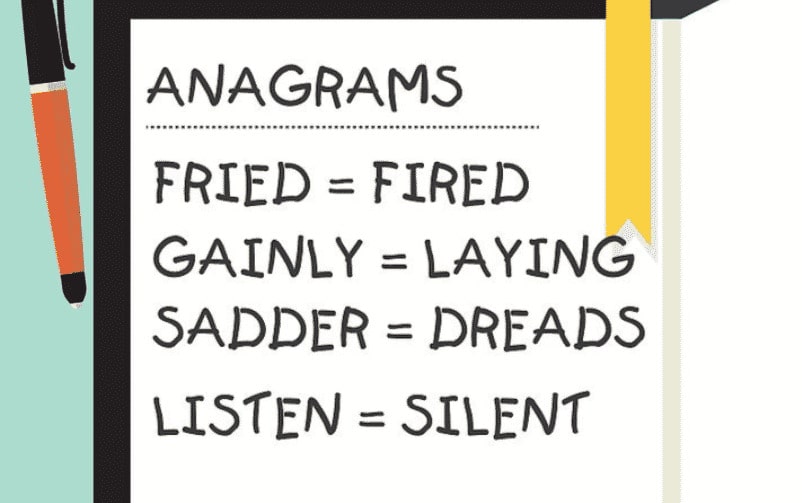
Think up a word and have everyone else try to figure it out. Expect some hilarious answers as everyone chips in.
How to play: Jumble up the letters but ensure that they create a five or six letter word anagram when correctly aligned. Only the presenter should suggest the word, and the activity should be timed. People can submit their answers live on MeetingPulse .
19. Two truths and a lie

The players get to tell two truths and one lie about themselves and the audience deciphers which one is the lie.
How to play: The player chooses a topic, like “career.” They tell two real facts about their career and one lie. The audience then decides which statement is false and why they believe that.
20. Choose the Agenda

In this activity, the participants choose the agenda of the meeting instead of being told what it is. This allow them to address burning issues.
How to play: Participants are invited to submit their agendas, which are shared by everyone and then voted on. The one with the most votes becomes the main agenda for the meeting. This gives participants control over the meeting as well.
You can use MeetingPulse’s brainstorming tool with the upvoting feature for this!
Final Thoughts
Now that you know some of the best interactive presentation games, you’re ready to host your next event with new and creative ways to keep your audience engaged. MeetingPulse is a great tool and resource for you to make your presentations more memorable and — dare we say it — fun.
Related: 25 Fun Poll Questions to Ask Your Audience
Get started with MeetingPulse today!
Share this article on your socials, latest posts.

Boosting Audience Engagement with Interactive Presentation Tools

Enhancing Employee Engagement with Interactive Meeting Software
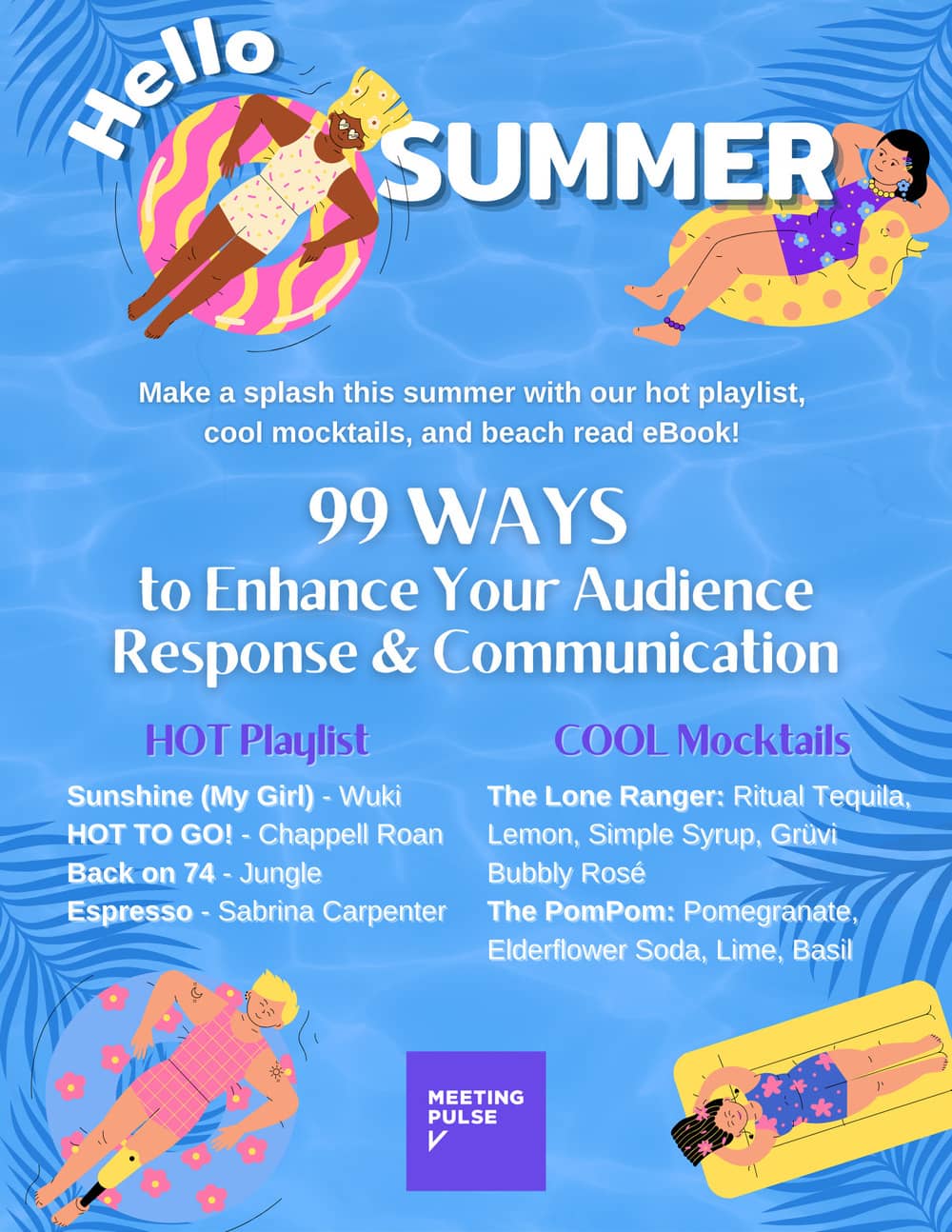
Cool Ideas for Your Hot Summer

The Benefits of Language-Inclusive Meetings and Events
Blog categories.
- Audience Response Tools
- Best Practices
- Employee Engagement
- Event Planning
- Hybrid Events
- Leadership Techniques
- Meeting Prep
- Organizational Development
- Uncategorized

To make MeetingPulse a seamless addition to your meetings, we offer custom themes. You can use your own logo and your colors in Attendee View as well as Broadcast View. Your company name can also be included in the webpage’s title. Your meeting can also have its own domain. This is great if you are going to promote your meeting offline. For example, you could use “acme2022.com” instead of “meet.ps/acme-all-hands”.

Live Product Tours
Weekly Product Tour Every Wednesday

- Success Stories
- Integrations
- Help Center
- Cvent Marketplace
- Connect with Zapier
- Trust Center
- System Status
- MeetingPulse User Reviews
- Skip to main content
- Skip to primary sidebar
- Skip to footer
- QuestionPro

- Solutions Industries Gaming Automotive Sports and events Education Government Travel & Hospitality Financial Services Healthcare Cannabis Technology Use Case AskWhy Communities Audience Contactless surveys Mobile LivePolls Member Experience GDPR Positive People Science 360 Feedback Surveys
- Resources Blog eBooks Survey Templates Case Studies Training Help center
Home LivePolls
15 Interactive Presentation Games to Engage Your Audience
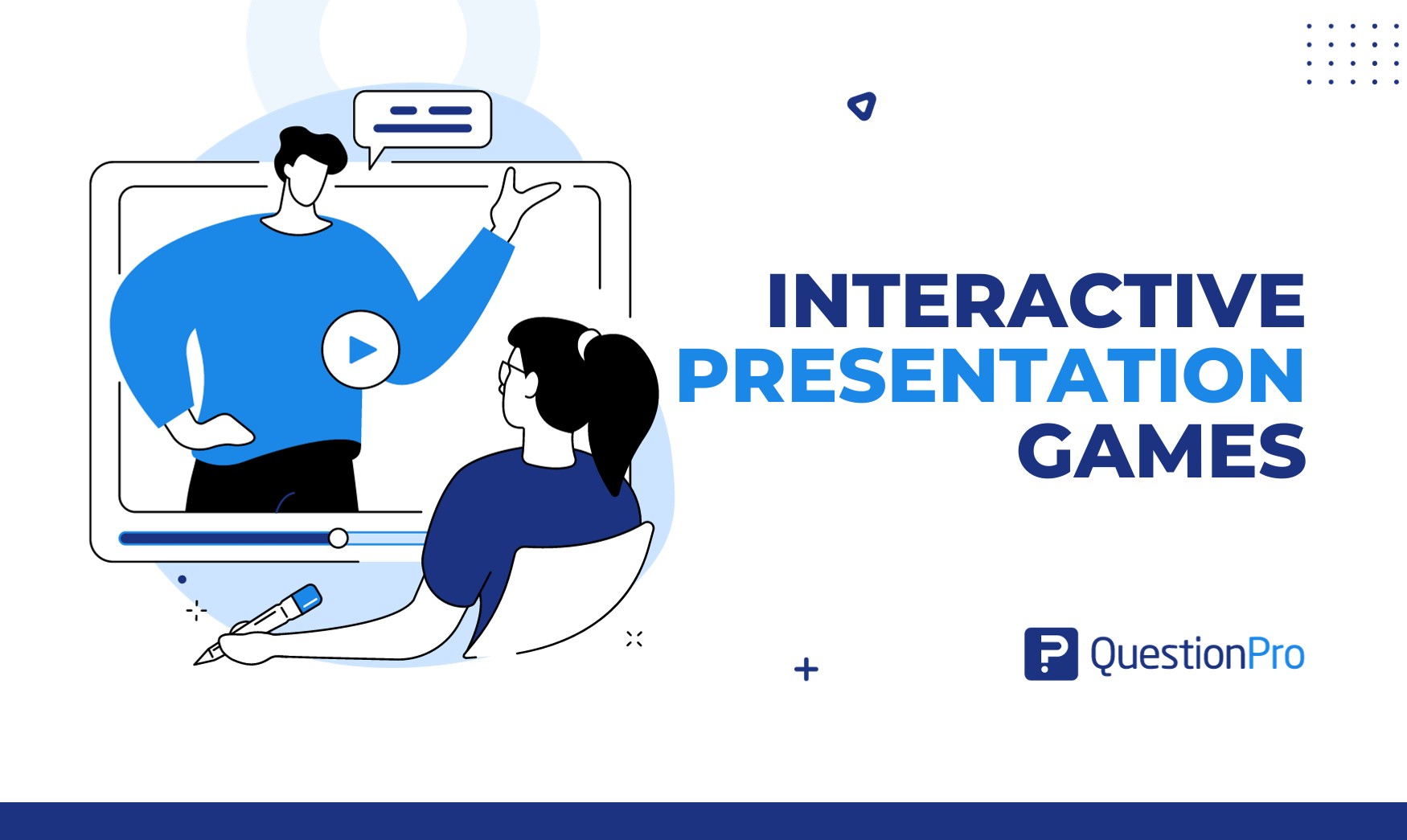
In the world of presentations and public speaking, engaging your audience is crucial. A captivating presentation can leave a lasting impact and ensure that your message is heard and retained. One effective way to achieve this engagement is by incorporating interactive presentation games into your talks.
Interactive presentation games break the monotony of traditional slideshows and transform passive listeners into active participants. In this blog, we’ll explore 15 interactive presentation games that can make your presentations more dynamic, memorable, and enjoyable for your audience.
Why Use Interactive Presentation Games?
Traditional presentations often involve passive listening, which can lead to disengagement and limited retention of information. On the other hand, interactive presentation games create an environment of active participation.
Making your presentations more memorable and impactful. They foster interaction, feedback, and collaboration, turning your audience into active participants rather than passive observers.
Benefits of Engaging Your Audience
Engaging your audience with interactive presentation games offers numerous benefits:
- Increased Engagement: Interactive presentation games grab your audience’s attention and keep them actively involved throughout the presentation.
- Improved Information Retention: Active participation enhances the retention of key information, ensuring that your message sticks with your audience long after the presentation is over.
- Enhanced Learning: Games encourage a deeper understanding of the subject matter, making it easier for your audience to grasp complex concepts.
- Better Audience Connection: By involving your audience, you establish a stronger connection, making them feel valued and heard.
- Immediate Feedback: Games provide opportunities for instant feedback, allowing you to address questions and concerns in real time.
- Fun and Entertainment: Interactive fun games add an element of fun and entertainment to your presentations, making them more enjoyable for your audience.
How to Choose the Right Presentation Games
Selecting the appropriate presentation games depends on your audience, topic, and objectives. Consider factors such as the size of your audience, the level of interactivity you desire, and the technology available. Tailor your choice of games to align with your presentation goals, ensuring they enhance your message rather than distract from it.
Now, let’s explore 15 interactive presentation games that you can incorporate into your presentations to engage your audience effectively:
01. Polling and Surveys
Polling and surveys involve asking questions to your audience and collecting their responses in real time. This game is useful for engaging the audience and gathering valuable data or opinions.
Example: During a marketing presentation, you can use polling to ask the audience which social media platform they use most frequently for product discovery, with response options like “Facebook,” “Instagram,” or “Twitter.” The results can guide your marketing strategy.
02. Quiz and Trivia
Quiz and trivia games challenge the audience’s knowledge of a specific subject. Correct-answer questions encourage competition and learning because participants’ scores are added up.
Example: In a history lecture, you can organize a trivia quiz about historical events. Ask questions like, “Who was the first President of the United States?” and award points for correct answers to make learning history engaging.
03. Interactive Q&A Sessions
Interactive Q&A sessions allow the audience to ask questions and engage in a live dialogue with the presenter. This interactive presentation game promotes engagement, clarification, and in-depth discussions.
Example: After a business strategy presentation, open the floor for an interactive Q&A session where the audience can ask questions about the proposed strategies, fostering a deeper understanding of the material.
04. Gamified Scenarios
Gamified scenarios present real-world situations or challenges to the audience. Participants make decisions, and the consequences of those choices are revealed, creating an immersive learning experience.
Example: In leadership training, simulate a business scenario where participants make decisions as managers. Their choices affect the company’s success, making the learning process engaging and interactive.
05. Virtual Reality and Augmented Reality Experiences
Virtual reality (VR) and augmented reality (AR) games provide immersive 3D experiences. Participants can explore virtual environments or interact with augmented elements.
Example: In a product launch presentation, use AR to allow the audience to visualize how the product would fit into their homes. They can use their smartphones to see a virtual presentation version of the product in their living rooms.
06. Storytelling Challenges
Storytelling challenges encourage participants to create and share their stories, fostering creativity and personal expression.
Example: In a team-building workshop, ask each participant to share a personal success story related to teamwork. This engages the audience and builds a sense of connection among participants.
07. Collaborative Whiteboard Activities
In real-time, collaborative whiteboard activities involve multiple participants contributing ideas, drawings, or annotations on a digital whiteboard. This game fosters teamwork and brainstorming.
Example: During a brainstorming session for a new project, use a digital whiteboard tool where team members can simultaneously sketch out their ideas and add comments. This promotes collaboration and idea generation.
08. Interactive Polls and Word Clouds
Interactive polls and word clouds engage the audience by having them vote or input keywords related to a topic. The results are displayed dynamically.
Example: In a conference PowerPoint presentation about technology trends, ask the audience to submit keywords related to the most exciting emerging technologies. Display the results in a word cloud to visualize the collective interest.
09. Simulations and Case Studies
Simulations and case studies replicate real-life scenarios for participants to make decisions and see the outcomes. This game is effective for practical learning.
Example: In a business strategy workshop, provide participants with a case study of a struggling company. Have them analyze the situation and propose strategies to turn the business around. The best solutions can be discussed as a group.
10. Role-Playing Exercises
Role-playing exercises involve participants taking on specific roles or characters to act out scenarios. This game promotes empathy and communication skills.
Example: In customer service training, participants can take on the roles of customers and service representatives. They act out various customer service scenarios to practice effective communication and problem-solving.
11. Breakout Rooms and Group Discussions
Breakout rooms and group discussions split the audience-focused audiences into smaller groups to discuss specific topics or tasks. This great game promotes active participation and in-depth exploration of ideas.
Example: In an educational webinar, use breakout rooms to divide participants into smaller groups. Each group discusses a different aspect of the topic and then shares their insights when they return to the main session.
12. Live Challenges and Competitions
Live challenges and competitions introduce competitive elements to the best presentation games. Participants can compete individually or in teams to solve problems or complete tasks.
Example: In a team-building event, organize a friendly competition where teams compete in a series of challenges. Challenges could include problem-solving tasks, physical activities, or trivia quizzes to foster teamwork and camaraderie.
13. Interactive Presentations
Interactive presentations incorporate multimedia elements, quizzes, and audience participation throughout the entire presentation screen to keep the audience engaged.
Example: During a product launch presentation, embed interactive elements such as polls, quizzes, and live demos within your slides. This ensures constant engagement and information retention.
14. Icebreakers and Energizers
Icebreakers and energizers are quick, fun activities designed to create a relaxed atmosphere and engage the audience at the beginning of a presentation or during breaks.
Example: At the start of a team meeting, use a fun icebreaker like “Two Truths and a Lie,” where each participant shares two true statements and one false one about themselves. It lightens the mood and promotes bonding.
15. Creative Challenges and Brain Teasers
Creative challenges and brain teasers stimulate creativity and problem-solving. They present puzzles, riddles, or creative tasks to engage the audience stand.
Example: During a creativity workshop, present participants with a riddle or a creative problem to solve as a group. Encourage them to think critically and come up with innovative solutions, fostering creative thinking.
How QuestioPro LivePolls can help in Interactive presentation games
When you use any tool for an interactive show, you need to think about how your audience votes and your presentation’s goals. Make sure the interactive elements enhance the learning or engagement experience rather than becoming a distraction.
Here are some ways a survey-based tool like QuestionPro can assist in creating interactive presentation games:
Question and Quiz Creation
Many interactive presentation game tools allow you to create questions and quizzes that you can integrate into your presentations. These questions can be multiple-choice, true/false, open-ended, or other formats. Participants can then respond to these questions during your presentation.
Interactive presentation fun game tools often include features that engage your audience. This can include things like timers for questions, leaderboards to display scores, and interactive survey elements that make your presentation more engaging and fun.
Feedback and Scoring
These tools typically provide instant feedback to participants. Correct answers might be rewarded with points, while explanations could follow incorrect answers. Scores are often tallied in real time, creating a competitive or gamified atmosphere.
Data Collection
Interactive presentation game tools can help you collect data on audience response software . This data can be valuable for assessing learning outcomes, understanding audience vote opinions, or tailoring your content to your audience’s preferences.
Customization
You can often customize the appearance and behavior of interactive elements to fit your presentation’s theme or style. This allows for creative and engaging presentations.
Audience Participation
Such tools enable audience members to actively participate and feel involved in your presentation. This can lead to higher engagement levels and better retention of information.
Reports and Analytics
Some tools provide analytics and reports after your presentation, which can help you assess the effectiveness of your interactive elements and the overall presentation.
Incorporating interactive presentation games into your talks can elevate your engagement, foster learning, and make your message more memorable. Whether you choose polls, quizzes, simulations, or storytelling challenges, tailoring the games to your audience and objectives is key.
By doing so, you’ll transform your presentations into dynamic and unforgettable experiences that leave a lasting impact on your audience. So, level up your presentations with these interactive games, and watch your audience become active participants in your message.
LEARN MORE CREATE FREE ACCOUNT
MORE LIKE THIS
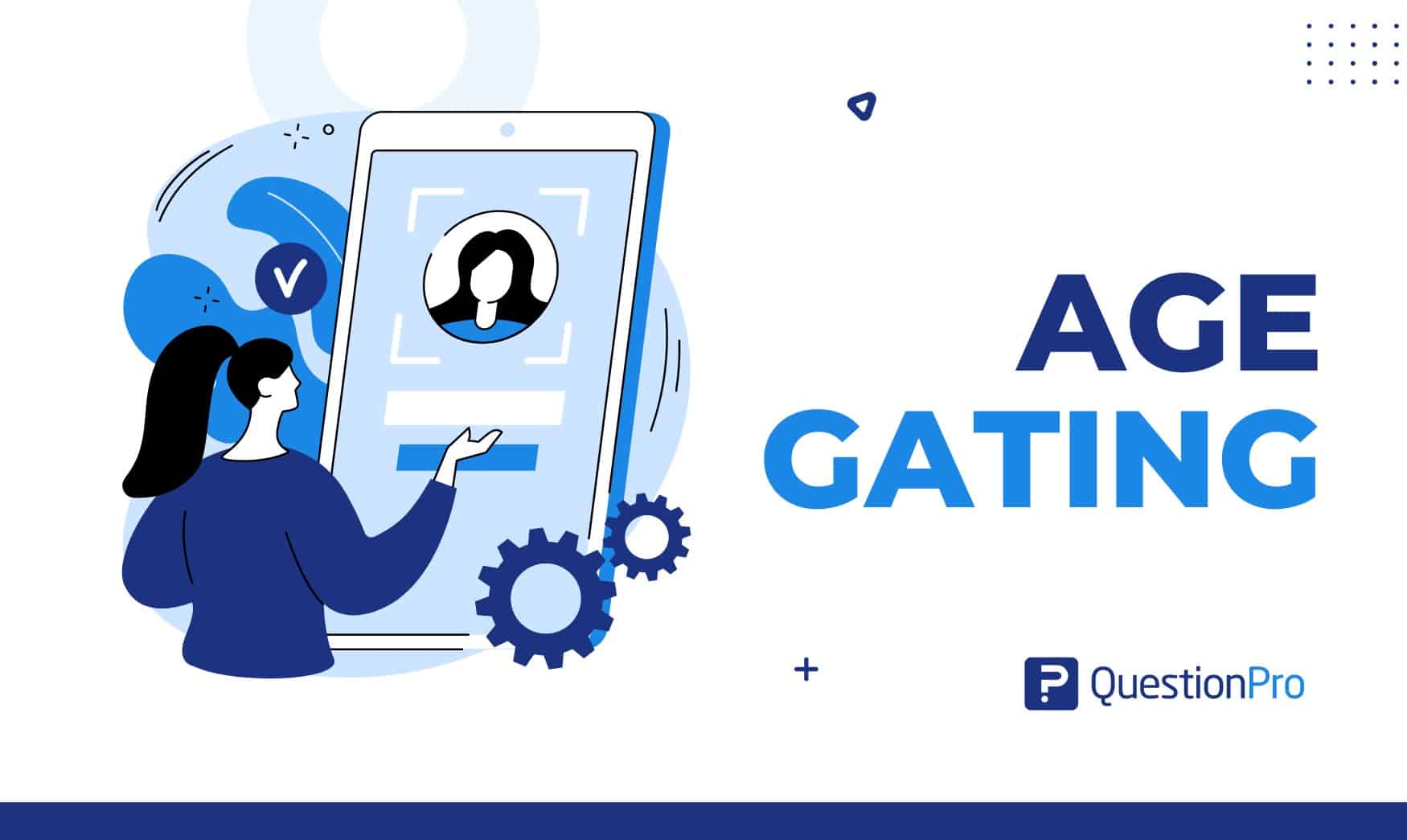
Age Gating: Effective Strategies for Online Content Control
Aug 23, 2024

Customer Experience Lessons from 13,000 Feet — Tuesday CX Thoughts
Aug 20, 2024

Insight: Definition & meaning, types and examples
Aug 19, 2024

Employee Loyalty: Strategies for Long-Term Business Success
Other categories.
- Academic Research
- Artificial Intelligence
- Assessments
- Brand Awareness
- Case Studies
- Communities
- Consumer Insights
- Customer effort score
- Customer Engagement
- Customer Experience
- Customer Loyalty
- Customer Research
- Customer Satisfaction
- Employee Benefits
- Employee Engagement
- Employee Retention
- Friday Five
- General Data Protection Regulation
- Insights Hub
- Life@QuestionPro
- Market Research
- Mobile diaries
- Mobile Surveys
- New Features
- Online Communities
- Question Types
- Questionnaire
- QuestionPro Products
- Release Notes
- Research Tools and Apps
- Revenue at Risk
- Survey Templates
- Training Tips
- Tuesday CX Thoughts (TCXT)
- Uncategorized
- What’s Coming Up
- Workforce Intelligence

Awake and interested: 21 Interactive presentation games

Have you ever worked hard on an important presentation, only to look out at the audience and see that they’re barely awake?
Don’t take it personally. It’s hard to get talked at for a period of time, especially if it’s been a long day already. That’s why experienced presenters often come to the table with interactive presentation ideas. These interactive presentation games will add a little extra fun to an otherwise straightforward presentation, and might be just what you need to keep your audience awake and interested.
Let’s face it: public speaking and presenting is rarely anyone’s favorite activity. Fearing that your audience isn’t engaged or is drifting off to sleep only makes things worse. Get creative with some interactive presentation games to engage your audience, keep them interested, and help them to actually retain the important information you’re sharing.
21 Interactive presentation games
These ideas are great for any kind of event - from a sales kickoff meeting to a work retreat . If you are planning a seminar or industry event, consider some of these options as additions to conference activities that attendees love.
1. Live trivia
A trivia competition is a safe and easy way to get people engaged and involved in the information. You can start your session with a trivia quiz based on any topic, or you can pause periodically and share trivia questions based on what you’ve presented already. For example, if you are presenting at a certain conference, you might choose questions that deal with the subject matter of the event. It’s pretty much fail-safe to pick some simple trivia questions to get everyone chatting at the beginning of your presentation, and if you want to create a competition you can break everyone up into small teams to see who knows the most. Tip: If you go the competition route, people will always be more engaged if there’s a prize involved.
2. Presentation singalong
This is a silly idea that’s sure to infuse your presentation with some fun and laughs. Start by choosing a popular song with a melody that will be easy for most people to pick up on. Then write down the lyrics, and swap some of the words out with concepts from your presentation. Essentially, you’ll keep the beat but change the words to items from your talk. Then create a slide to share during your presentation and “teach” everyone the song. People will be singing along and likely remember your presentation all day! You’ll want to know your audience fairly well for this one; not everyone likes singing in public and some people will only feel embarrassed, not entertained. For people who are comfortable laughing at themselves, it’s a winner!
3. 20 questions
This is a simple and classic question game that doesn’t require any preparation or investment. You can be the subject and the people you’re presenting to can help you to answer. Choose someone from the audience and have them write down or draw something on the board behind you. Then, ask the audience a series of questions to get to the answer of the mystery item. The game traditionally allows yes or no questions rather than open-ended ones. For example, “Is the item an animal?” or “Is the item bigger than my fist?” You might try to have them keep the answer relevant to your presentation, but that can be tough depending on the subject matter. If you go that route, try to make the game a mid-session break, where they focus on something from your presentation so far.
4. Same-room scavenger hunt
For a twist on a classic game (that doesn’t require leaving the presentation room), put together a scavenger hunt full of items that people will either have on themselves, or ask other attendees for. Things like a certain style of pen, a diet coke, a cellphone photo of a famous landmark, a green hairband, etc. Try to choose things that people will have in their bag or on their person - but pick a few things that they’ll likely have to ask around for. That way they can move about the room a little bit, as well as strike up conversation with others. You might be surprised how much people are able to grab without having to leave the room! Set aside a few prizes for the winners, and bonus points for people who get extra resourceful.
5. Show and tell
This game can serve as a sort of icebreaker and is ideal for smaller groups , or groups who don’t know each other well. It requires a little preparation, as before the event you’ll ask everyone to bring an item such as a favorite song or beloved photo - anything that tells a bit about what matters to them. Then, before your presentation begins, have everyone introduce themselves and explain why they brought the item they chose. Have your technology lined up in advance, so that if it’s a photo, you’re able to enlarge it on a screen, or if it’s a song, it can be played. This is a great way to learn more about your fellow attendees and find commonalities that can form friendships.
6. Periodic poll questions
Break up a lengthy presentation by having people share their opinions. Throughout your presentation, place a few polls or surveys that people can take informally. You can keep things simple by just having members raise their hands for their chosen option, or you can download an app so that you can collect responses in real-time. Try to make the topics pertinent to your presentation, and choose questions that are engaging and likely to have different opinions. You don’t want to choose questions where the answer will be obvious; that doesn’t lead to great conversation - which is your goal.
7. True or false game
This activity is another one that allows people to move and stretch, which can be really beneficial during long or dry presentations. Prepare some slides in advance with one statement per slide. The statements can be just for fun, like about pop culture, or about the subject matter of your presentation (this is a good way to see who is paying attention). The key is that some should be true and some should be false. Think of it like a true or false quiz based on the information you’ve shared. Have the entire audience stand up, and then display the slides one-by-one. Tell them to stay standing if they believe the statement is (rightfully) true, and sit down if they believe it’s false. After each round, say whether the comment was true or false. Anyone who was wrong must now sit down permanently. Continue this process until only one person is left standing as the winner.
8. Controversial questions
A bit of light-hearted controversy is a good way to get people engaged and to get conversation flowing. Energize your group with some questions that will spark debate. Obviously, you don’t want to create discomfort or irritation, so it’s good to avoid topics like politics, religion, current world events, etc. Keep questions on the fun side like “Mountains or beach - and why?” or “Coffee is overrated - yes or no.” Have everyone decide which side of the debate they are on and then join their “teammates”. Have the groups debate and see if anyone ends up changing their mind.
9. Word of the day
If you want to ensure people pay more attention to your talk, start things off with a word of the day. This is particularly effective if you are doing a multi-day engagement and can change the word each day. At the beginning, tell everyone what the word of the day is. Then make sure it’s interspersed throughout your presentation. Have everyone keep a tally of how many times the word was mentioned, and whoever gets the right number wins.
10. Process of elimination
This activity is simple, yet fun, and can help people get to know each other as well. You can choose to kick off your presentation with it, or use it as a break part way through your presentation. It requires a little preparation; before your event come up with a list of “yes or no” questions. On the day of, have everyone begin by standing up. Then ask each question one by one, and have people continue standing if their answer is yes, and sit down if their answer is no. If you want to thin the crowd earlier and make the game move faster, try suggesting scenarios instead of a question. For example, “Stay standing if you have ever seen a reindeer in real life”. Eventually you will get down to one person, who can be crowned the winner.
11. Large group icebreakers
Not all icebreakers are the same. Some are great for meeting new people and interacting with the person next to you; others are good for getting an entire group engaged. Research icebreakers designed for large groups (our blog is a great place to start).
12. Interactive Q & A session
An activity that’s actually really valuable to your attendees is a live question and answer session. This way they can learn more about what you’ve presented and gain a deeper knowledge. Plus, more outspoken people tend to ask questions that everyone is thinking, so it can be really helpful for everyone present. Let everyone know that at the end of your speaking portion you’ll leave time for questions. Make sure to allot about 20 minutes or more and encourage people to share any questions they have, letting them know you’ll answer to the best of your ability.
13. Business case study
Simulations and case-studies represent real-life scenarios that people must solve. This can be an interesting and educational activity for people who are at an industry conference or other learning-style event, particularly with a business focus. To encourage really practical learning, try providing participants with a case study about a struggling company. Participants should analyze the situation and come up with a few suggestions for turning things around. Have everyone share their insights and then dive deeper into the best ideas from the group.
14. Storytelling challenge
If you want to focus on fostering creativity and personal expression, try a storytelling challenge where everyone must create and share a story. For example, if you are hosting a team-building workshop , have each individual talk about a time they were part of a really effective team. What made them successful and what can other people take away from their story? This also helps to build a sense of connection among the audience.
15. Collaborative whiteboard
This real-time activity involves having everyone present work together to contribute ideas, drawings, or annotations to a white board. It can really add an element of teamwork and brainstorming which can be powerful. If coming up with suggestions is part of your event, try having a large whiteboard and allowing people to come up and add their thoughts one by one. You can also use a digital white board tool to keep things a bit cleaner. Then share the ideas generated and consider giving people a few minutes to write down all of the results.
16. Role-playing exercise
To promote empathy and communication skills, try coming up with role-playing games where participants will take on different roles or act as characters in various scenarios. For example, if you want to do customer service training, you might have one person play the role of a customer service representative and another of the role of a difficult customer. Allow them to act out various scenarios to practice problem-solving .
17. Breakout tables
If you are presenting to a larger audience, why not try breaking them up into smaller groups to facilitate more discussions on specific topics or tasks? This is a good way to facilitate teamwork, collaboration, and a deeper dive into topic exploration. If the space allows, you can have separate breakout rooms instead of just tables. In a smaller space, divide the room with tables at the four corners so each group has room to speak comfortably without disturbing the other groups.
18. Brain teaser
Flexing creative muscles and problem-solving are always welcome skills, no matter what the subject matter is. Come up with some challenges or brain teasers to present to your group (or smaller groups if presenting to a larger audience). Puzzles , riddles , creative tasks, or critical thinking exercises are all welcome additions that will get people moving, chatting, and thinking. Try some of these guessing games for extra fun.
19. Interactive quiz
Want to see how much people are paying attention? Why not spring a pop quiz on them, just like in high school? We are only partly kidding. If you are presenting during a particularly long day, or on a complex topic, take periodic breaks and toss out a few quiz questions. This is especially valuable if you announce at the beginning of your presentation that you’ll be sharing some quiz questions throughout the day - then people know they need to pay attention. Pick a few key points from your talk and ask some fairly simple questions that the audience can answer.
20. Topic of the day
If you are part of a multi-day event covering a variety of topics, you’ll get better engagement if your audience can help direct the material. Let them know in advance that you are going to keep your presentation fluid and reserve the last 20 minutes (or whatever amount of time makes sense) for a discussion on a topic of their choice. At this time, ask your audience what they want to learn more about. This is a great idea for events that last more than one day because you can build on what you previously shared. For example, if you present on Topic A on Monday, and Topic B Tuesday, ask your group on Tuesday if they would rather dive deeper into Topic A or if they want to spend more time on Topic B. Leaving it up to them will ensure they find real value in whatever is discussed.
21. Partner assignment
For a business-focused conference, networking and meeting other professionals is part of the appeal. Kick things off well by having everyone pair up with someone they don’t know. Then assign a simple exercise where they need to work together. For example, task them with coming up with a new name for a traditional product. They’ll get to work on communication and critical thinking skills while building a bond with someone in the same industry.
Make your all-company meeting complete
Anytime that you can bring your entire group together for a team meeting or all-hands event, you have the opportunity to insert a little fun. Try some of these ideas during your next team building retreat or even when you just need some quick team-building ideas.
If you need help in figuring out the flow, and how to plan an event that all of your attendees will be talking about for years, reach out to Surf Office for expert event advice .

free course
How to plan your first company retreat

Retreat Budget Spreadsheet
Are you organising a company retreat and want to make sure you have all the costs under the control?
Get a copy of our free Budget Calculator spreadsheet.

160 One must go questions for every working environment!

Scout out your future-leaders with 20 leadership icebreakers

37 Fun Zoom icebreaker games for virtual meetings

29 Watercooler talk topics + Do’s and Don’ts!

180 Engaging team-building questions for work
Organize your next company retreat with surf office, 💌 join 18,000+ managers receiving insights on building company culture that people love., stay in touch, work with us.
- Alternatives
How to Make a Presentation Interactive | 7 Great Ways
Lakshmi Puthanveedu • 29 July, 2024 • 11 min read
Are your presentations putting people to sleep faster than a bedtime story? It’s time to shock some life back into your lessons with interactivity🚀
Let's defibrillate “Death by PowerPoint” and show you lightning-quick ways how to make a presentation interactive .
With these tips, you'll be able to activate that dopamine drip and get butts in seats leaning in - not delving deep into the chairs!
Table of Contents
What is an interactive presentation.
- Why Use an Interactive Presentation?
#1. Create icebreaker games🧊
- #2. Make use of props 📝
#3. Create interactive presentation games and quizzes 🎲
#4. tell a compelling story, #5. organise a brainstorming session, #6. make a word cloud for the topic, #7. bring out the poll express, easy interactive activities for presentations, more presentation examples you could learn from.
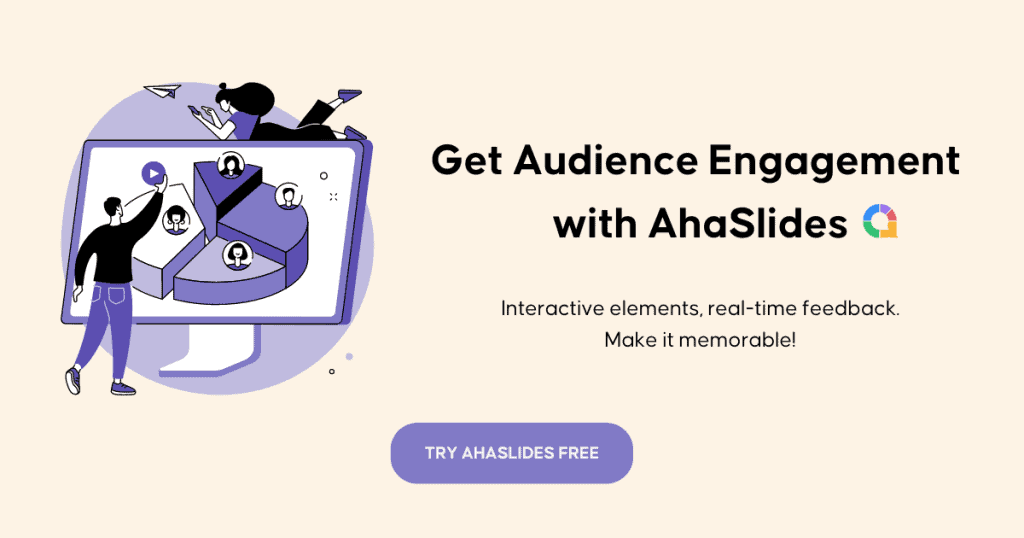
Keeping your audience engaged is the most critical and challenging part, regardless of the topic or how casual or formal the presentation is.
An interactive presentation is a presentation that works two ways. The presenter asks questions during the production, and the audience responds directly to those questions.
Let's take an example of an interactive poll .
The presenter displays a poll question on the screen. The audience can then submit their answers live through their mobile phones, and the results are immediately displayed on the screen, as shown in the image below. Yay, it's an interactive slide presentation .

Making an interactive presentation does not have to be complex or stressful. It’s all about letting go of the static, linear presentation format and using some tools and techniques to create a personal, more involved experience for the audience.
With software like AhaSlides , you can easily create interactive presentations with tons of interactive quizzes, polls, and live Q&A sessions for your audience. Keep reading to find out fired tips on how to make a presentation interactive 👇
Why Interactive Presentation?
Presentations are still one of the commonly used methods to pass on information. Still, no one likes to sit through long, monotonous presentations where the host doesn’t stop talking.
Interactive presentations can help. They...
- Increase audience engagement , allowing them to connect with you and the purpose of the presentation. 64% of people believe a flexible presentation with two-way interaction is more engaging than a linear one.
- Improve retention capacity . 68% say that it’s easier to remember the information when the presentation is interactive.
- Tips: Use a rating scale to gather feedback !
- Act as a break from the routine and allow participants to have an enjoyable experience.
How to Make a Presentation Interactive
Whether you are hosting a virtual or offline presentation, there are many ways to make presentations interactive, exciting and two-way for your audience.
Starting a presentation is always one of the most challenging parts. You are nervous; the audience might still be settling, there might be people not familiar with the topic - the list could go on. Get to know your audience, ask them questions about how they are feeling and how their day was, or maybe share a funny story to get them hooked and excited.
🎊 Here are 180 Fun General Knowledge Quiz Questions and Answers to gain better engagement.
#2. Make use of Props 📝
Making a presentation interactive does not mean you have to let go of traditional tricks of engaging the audience. You could bring a lighting stick or a ball to pass around to the audience when they want to ask a question or share something.
Games and quizzes will always remain the star of the show, no matter how complex the presentation is. You don’t necessarily have to create them related to the topic; these could also be introduced into the presentation as fillers or as a fun activity.
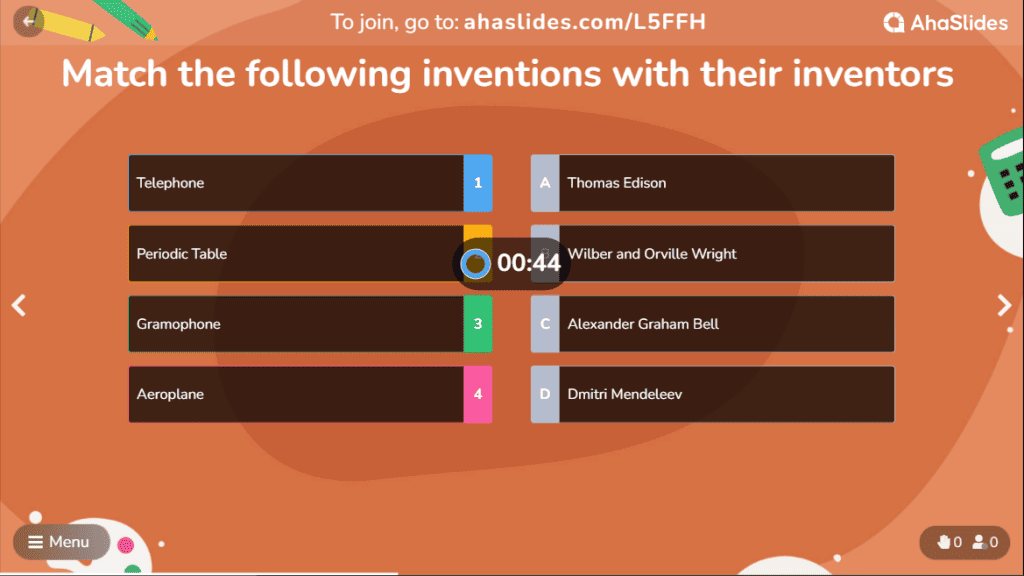
💡 Want more? Get 10 interactive presentation techniques here!
Stories work like a charm in any situation. Introducing a complex physics topic? You could tell a story about Nicola Tesla or Albert Einstein. Want to beat the Monday blues in the classroom? Tell a story! Want to break the ice ?
Well, you know… ask the audience to tell a story!
There are many ways you could use storytelling in a presentation. In a marketing presentation , for instance, you can create empathy with your audience by telling an engaging story or asking them if they have any interesting marketing stories or situations to share. If you're a teacher, you could pitch an outline to the students and ask them to build the rest of the story.
Or, you could tell a story till just before the ending and ask the audience how they think the story ended.
You’ve created a stellar presentation. You’ve introduced the topic and are mid-way through the exhibition. Wouldn’t it be nice to sit back, take a break and see how your students put some effort into taking the presentation forward?
Brainstorming helps get the students excited about the topic and allows them to think creatively and critically.

💡 Get an engaged class with 6 more interactive presentation ideas
Want to make sure your audience gets the concept or topic of the presentation without making it feel like an interrogation?
Live word clouds are fun and interactive and ensure the main topic is not lost in the presentation. Using a word cloud free , you can ask the audience what they think is the main topic for the production.
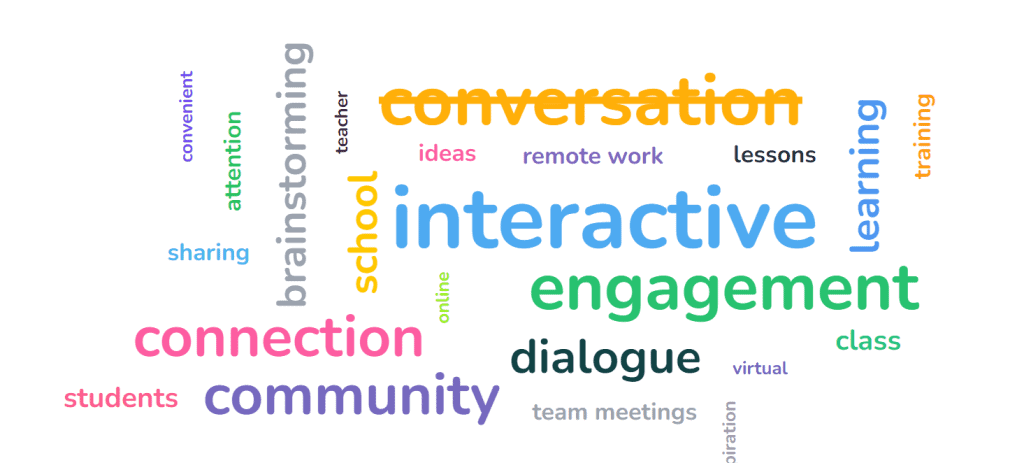
How do you feel about using visual aids in your presentation? It's not anything new, right?
But what if you can merge funny pictures with an interactive poll? That's got to be interesting!
“How do you feel right now?”
This simple question could be turned into an interactive fun activity with the help of images and GIFs describing your mood. Present it to the audience in a poll, and you could display the results on the screen for everyone to see.
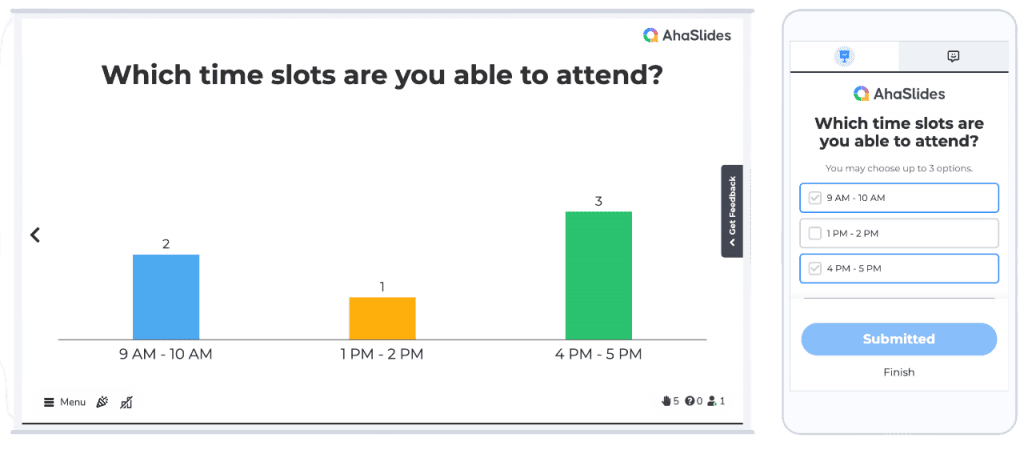
This is a great, super simple icebreaker activity that can help revitalise team meetings, especially when some folks are working remotely.
💡 We've got more - 10 interactive presentation ideas for work .
Whether you’re hosting something for your colleagues, students or friends, retaining their attention for a while can be a daunting task.
Games such as What Would You Do? and 4 Corners are easy interactive activities to help the audience get back on track with your presentation …
What Would You Do?
Isn’t it interesting to know what someone would do in a particular situation or how they would handle it? In this game, you give the audience a scenario and ask how they would deal with it.
Say, for example, you are having a fun night with your friends and family. You could ask questions like, “What would you do if you could be invisible to the human eye?” and see how they handle the given situation.
If you've got remote players, this is a great interactive Zoom game .
This is a perfect game for anyone with an opinion. It’s a great way to start a conversation on your presentation's topic before diving into the meat of it.
You announce a statement and see how everyone feels about it. Each participant shows how they think by moving to one corner of the room. The corners are labelled ‘strongly agree’, ‘agree’, ‘strongly disagree’, and ‘disagree’.
Once everyone has taken their place in the corners, you could have a debate or discussion between the teams.
🎲 Looking for more? Check out 11 interactive presentation games !
The 5 Best Interactive Presentation Software
Making a presentation interactive is so much easier with the right tool.
Many interactive presentation websites let your audience respond directly to the content of your presentation and see the results on the big screen. You ask them a question in the form of a poll, word cloud, brainstorming or even a live quiz, and they respond with their phones.
#1 - AhaSlides
AhaSlides presentation platform will let you host fun, interactive presentations for all your needs, with quizzes, live Q&As, word clouds, brainstorming slides, and such.
The audience can join the presentation from their phones and interact with it live. Whether you are presenting to your students, a businessman who wants to hold team-building activities, or someone who wants to have a fun quiz game for your friends and family, this is a great tool you can use, with a ton of fun interactive options.
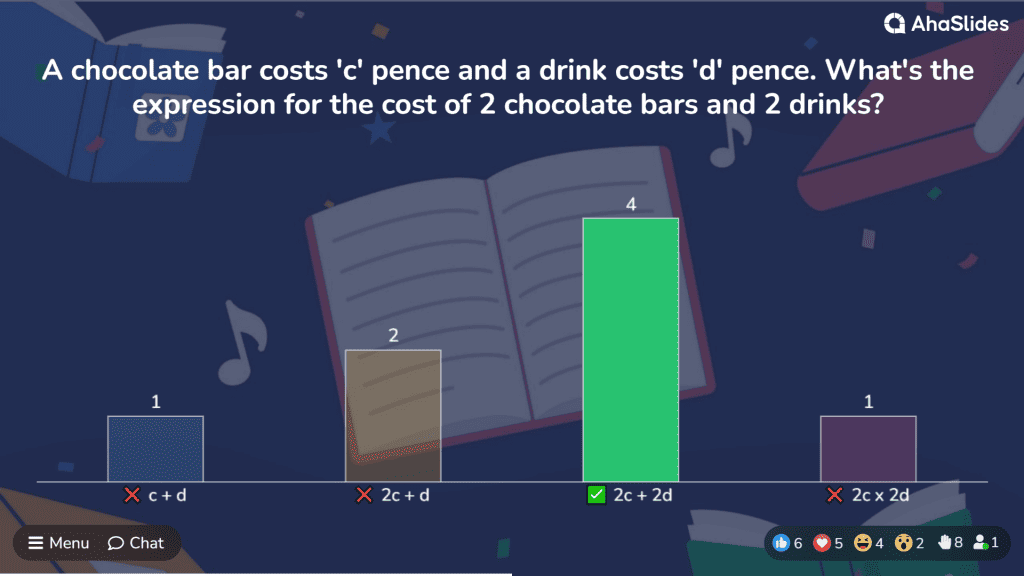
If you are looking for ways to boost your team’s creativity at your workplace, then Prezi is an excellent tool.
It is a bit similar to how a standard linear presentation would be but more imaginative and creative. With a huge template library and many animated elements, Prezi lets you create a cool, interactive display in no time.
Although the free version does not come with many features, spending a little on the tool is worth it to create content for any occasion.
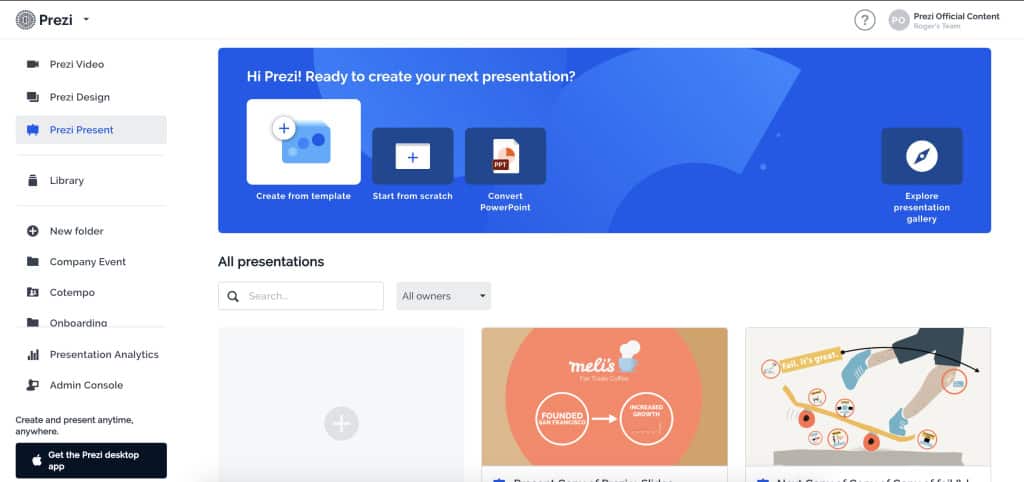
🎊 Learn more: Top 5+ Prezi Alternatives | 2024 Reveal From AhaSlides
NearPod is a good tool that most educators would get a kick out of. It is specifically designed to cater to educational needs, and the free basic version lets you host a presentation for up to 40 students.
Teachers can build lessons, share them with students and monitor their results. One of the best features of NearPod is the Zoom integration, where you can merge your ongoing Zoom lesson with the interactive presentation.
The tool also has various interactive features such as memory tests, polls, quizzes and video embedding features.
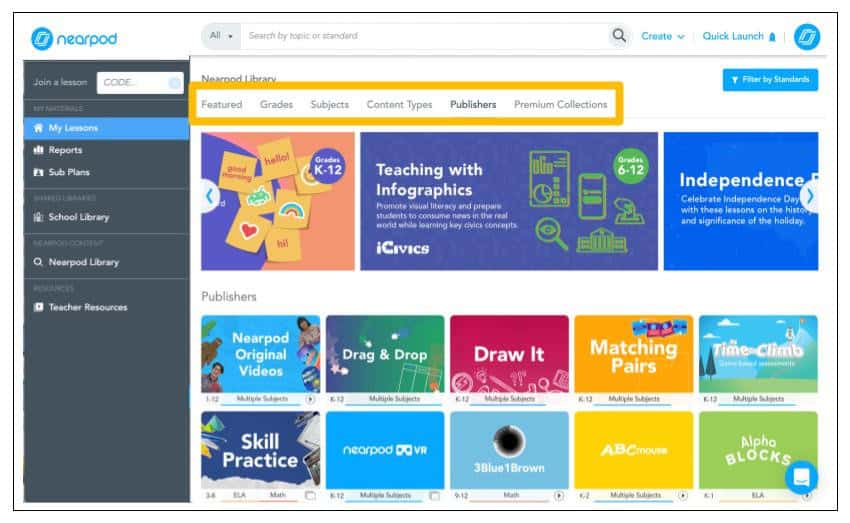
Canva is an easy-to-use kit that even a person with no design experience could master in a few minutes.
With the drag-and-drop feature of Canva, you can create your slides in no time and that too with copyright-free images and a ton of design templates to choose from.
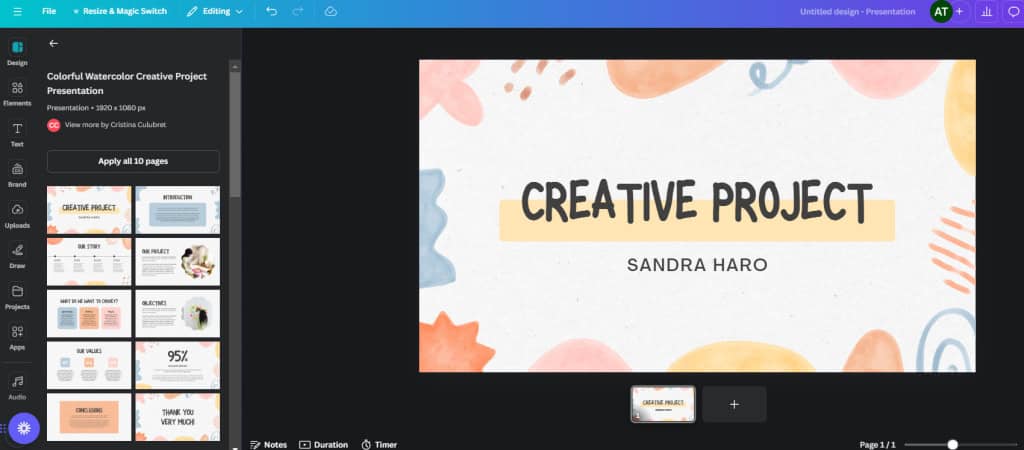
🎉 Learn more: Canva Alternatives | 2024 Reveal | Updated 12 Free and Paid Plans
Keynote for Mac
Keynote is one of the most popular bits of presentation software for Mac . It comes pre-installed and can be easily synced to iCloud, making it accessible across all Apple devices. Along with creating engaging presentations, you can also add a little bit of creativity by adding doodles and illustrations to your presentation.
Keynote presentations can also be exported to PowerPoint, allowing flexibility for the presenter.

Frequently Asked Questions
How do i make my presentation more interactive.
You can make a presentation more interactive with these 7 simple strategies: 1. Create icebreaker games 2. Make use of props 3. Create interactive presentation games and quizzes 4. Tell a compelling story 5. Organise a session using a brainstorming tool 6. Make a word cloud for the topic 7. Bring out the Poll Express
Can I make my PowerPoint interactive?
Yes, you can use PowerPoint's AhaSlides add-in to save time and effort while still being able to create interactive activities like polls, Q&A or quizzes.
How can you make presentations interactive to get students involved?
Here are some effective ways to make presentations more interactive and get students involved: 1. Use polls/surveys 2. Use quizzes, leaderboards, and points to make the content feel more game-like and fun. 3. Pose questions and cold call on students to answer and discuss their thinking. 4. Insert relevant videos and have students analyse or reflect on what they saw.
- Presentation outfit
- TED talks presentation
- Body language during a presentation
- How to get over Stage Fright
- Personality in a presentation
- Benefits of presentation software
- Zoom presentation tips
- Easy topic for presentation
To help you craft an impactful presentation, let's explore some common pitfalls and how to overcome them
- Bad speeches
- Bad presentation at work
- Death by PowerPoint

Lakshmi Puthanveedu
A small-town girl enthralled by culture, languages, and sunsets. Casual artist and musician looking to make memories every step of the way. Now changing the way humans live and have virtual interactions with AhaSlides.
Tips to Engage with Polls & Trivia

More from AhaSlides

The 12 Best Online Games for Groups and Classrooms

Discover the perfect solution for engaging groups and classrooms—online educational games. Transform lessons into lively, interactive experiences, making learning fun and inclusive. From math to history, these games enhance engagement and productivity, making them ideal for teachers and students alike. Explore our top 12 picks and revolutionize your classroom experience!
12 Best Online Group Games
Game #1: Starting the Morning on the Right Foot ( Good Morning Class )

"Good Morning Class" is an interactive icebreaker that sets the stage for an awesome, motivated classroom, where learning is a blast and everyone's engaged.
To play, create a presentation on "Slides with Friends," start the event, and have your students join via smartphone. Ask questions through the seven slides and foster discussions for communication. Conclude the game by summarizing responses and transitioning to the lesson.
“ Good Morning Class” is suitable for all age groups. This fun game can seamlessly become a part of your learning journey, offering benefits like fostering camaraderie, as well as improving communication, engagement, and digital skills.
Game #2: Building Vocabulary (First Letter, Last Letter)
“First Letter, Last Letter” challenges players to showcase their vocabulary and quick-thinking skills. To play, you simply have a back-and-forth conversation — except there's one rule: each person must begin their next sentence or word with the letter the last person ended on. For example, if the first player says “I love apples”, the next must start their sentences with an s , like “Sure, but are they as good as oranges?.”
"First Letter, Last Letter" is typically suitable for students who are at least in elementary school or around 6-7 years old. It can be integrated into language lessons, making vocabulary, spelling, and word links a total hoot!
Game #3: Put Your General Knowledge to the Test ( Virtual Trivia )

"Virtual Trivia" is a digital twist on the classic knowledge-testing game. Create a set of topic-specific trivia questions, form teams, and award points for correct answers. The age limit varies based on the game itself. There are cool trivia games made just for kids as young as 6 or 7.
You can also use “Slides with Friends” to create fun trivia quizzes. You get to choose from a number of exciting interactive templates that you can customize or enjoy right away. Want a quick game? Try out the “ Travel Trivia ” game which contains 12 slides and will take no more than 15 minutes. Or, if you're in for an epic trivia marathon, the Huge Movie Trivia game's got you covered with movie poster guessing and famous quotes to keep you entertained for more than an hour.
By incorporating trivia questions into their lessons, teachers can make sure that their students understand important concepts while keeping them engaged and excited. It's about working together and remembering cool facts, making the overall learning experience even more engaging.
Game #4: Digital Drawing Fun (Virtual Pictionary)

“Virtual Pictionary” brings the classic drawing and guessing game into the digital realm! Most online Pictionary games recommend an age range of approximately 8 to 10 years and older.
To play, divide students into teams and choose words to draw. In each round, one team member becomes the illustrator, racing against the clock to depict the chosen word while teammates guess. No letters, numbers, or talking allowed!
“Virtual Pictionary” can become a creative classroom tool for teachers to enhance vocabulary and artistic talents with loads of fun. They can weave in educational themes and subject-related words, allowing students to brush up on their knowledge while having a blast drawing and guessing.
Game #5: Interactive Wordplay Fun (Scattergories)
“Scattergories” is a word game where players must think of words that start with a specific letter and fit into given categories within a time limit. To play it online, gather your students, and when a round begins, you'll receive a category and a starting letter. Think up unique words that match both, and if no one else picks the same word, you score a point. Online “Scattergories” typically works best for players aged 12 and up.
Teachers and educators can use this fast-paced game to boost their students' vocabulary, critical thinking, and creativity. It's an interactive method to foster group dynamics, enhance communication, and refine problem-solving skills .
Game #6: Guessing Game Fun (Heads Up)
Online “Heads Up” is a great game for encouraging group interaction in the classroom. Players take turns guessing a word displayed on their foreheads, relying on their classmates' clues to figure it out. Typically, the online version of “Heads Up” is best suited for children around 8 years old or older.
Virtual “Heads Up” isn't just for fun; it can be a clever learning tool too! Teachers can tailor categories to match the curriculum, making lesson reviewing great fun. This game encourages teamwork, quick thinking, and communication skills, all while making learning an absolute blast!
Game #7: Treasure Hunt in the Digital Classroom ( Digital Scavenger Hunt )

Digital “Scavenger Hunt” is a great classroom game where the teacher curates a list of items and tasks that students must complete within a designated time frame. To make it educational, the items and activities can be connected to the lesson, adding a fun and engaging twist to learning. Typically, children around 8 years old and above can understand and enjoy the game.
Teachers can incorporate Digital “Scavenger Hunt” into lessons to reinforce concepts. By linking tasks to specific topics, it transforms the classroom into a lively arena of learning. Plus, it encourages collaboration and critical thinking, making learning feel like a thrilling treasure hunt!
Game #8: World Map Challenge ( Geography Puzzles )
“Geography Puzzles” puts your class's global knowledge to the test while fostering group interaction in a fun way. To play, send students a blank world map and challenge them to fill it out with as much accuracy as they can. You can use the Puzzle Masters Deck by Slides with Friends to create custom geography puzzles tailored to your students’ level of knowledge, adding an extra layer of excitement to the game. It's generally suitable for upper elementary students (around 10-11 years old) and older.
“Geography Puzzles” is a clever way to sprinkle some fun into your geography lessons. Teachers can tailor the challenge to match the class's skill level, making it a fantastic tool to learn and review countries, capitals, and more.
Game #9: Interactive Choice Game (Would You Rather)
"Would You Rather" is a delightful icebreaker that encourages students to engage in lively discussions and share their preferences. To play, compile a list of thought-provoking prompts, and start the online lesson by asking students to choose between two intriguing options. Here is an example of an engaging "Would You Rather" question: “Would you rather have the intelligence of Hermione Granger from Harry Potter or the courage of Katniss Everdeen from The Hunger Games?”
"Would You Rather" is a versatile teaching tool. Teachers can customize prompts to link with lesson content, sparking discussions that reinforce classroom concepts. It promotes interaction, critical thinking, and retention of information while making learning an enjoyable adventure. The game is generally suitable for students around 10-11 years old and older.
Game #10: Questioning Challenge Game (20 Questions)

"20 Questions" divides students into two groups, where one group thinks of an item, and the other group asks ten strategic yes-or-no questions to guess the object. Typically, “20 Questions” is appropriate for upper elementary students and older.
For example they might ask “Is it alive?” - yes. “Is it a person?” - yes. “Do I know them?” - yes. “Is it our teacher?” yes!
Teachers can tailor the game to any subject, sparking critical thinking and discussion. It promotes teamwork, effective communication, and problem-solving skills while making the classroom environment more interactive and enjoyable.
Game #11: Collaborative Storytelling (Complete a Story)
If your goal is to ignite creativity and a love for reading in your students, try playing "Complete a Story". It's all about giving your students a starting line or prompt, like "a boy running down the hill," and watching as students craft imaginative stories around it.
Typically, this game can be enjoyed by children in upper elementary grades, but it can be adapted for younger children with simpler prompts. To play "Complete a Story" online, you generally need access to a shared document or a more specialized online platform or app designed for collaborative storytelling .
In addition to boosting creativity and reading skills, "Complete a Story" fosters collaboration, sparks imaginative thinking, and helps students hone their comprehension skills, all while having a great time in the learning process.
Game #12: Memory Challenge Game (Sharp Memory)
"Sharp Memory" is a fun way to exercise your students’ memory muscles! You'll need to gather a few items like a pencil, mug, and chocolates, and then give your students a quick 20-second glimpse. Challenge them to list as many items as they can remember, and the student with the most items wins the game.
The game is typically suitable for children aged 6 and older. To play "Sharp Memory" online, you need a camera to display the chosen objects and a platform for sharing the video feed.
Teachers can use "Sharp Memory" to boost memory in a fun way. This engaging activity improves focus, quick thinking, and recall abilities, making learning a fun and interactive experience in the classroom.
Subscribe for more articles like this
Try slides with friends for free.
The easiest way to host meetings your team will love
Engagement delivered to your inbox
We'll email you 1-2x per month with brand new, ready-to-run events and ideas. Subscribe to stay ahead of the curve and keep your lessons, meetings, and events fresh and engaging.
Game On! How to Easily Create and Play PowerPoint Games

Sylvia Nguyen
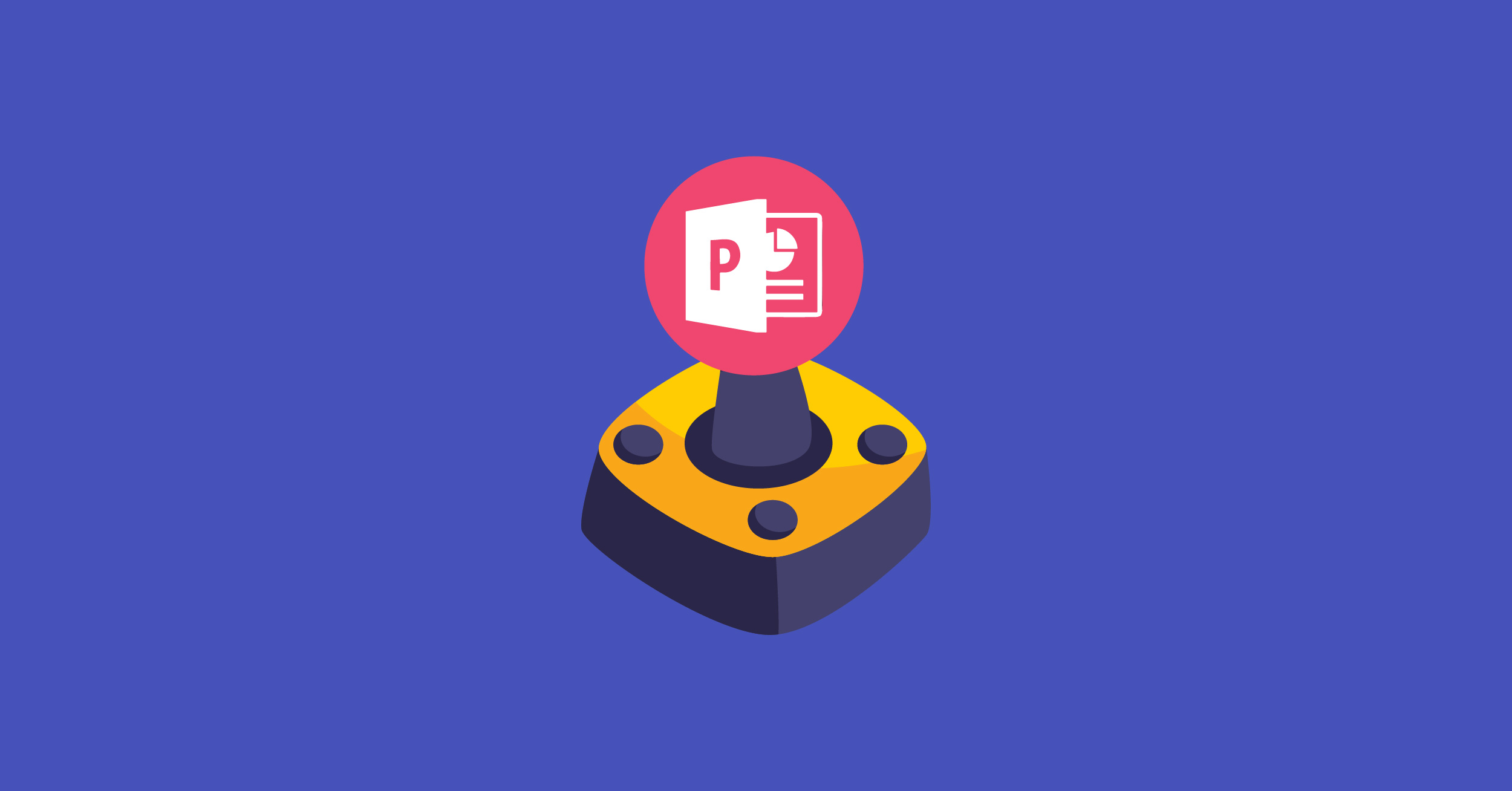
Do you know that PowerPoint can actually be fun? Yes, you definitely read it right, PowerPoint can be fun and engaging with just a little of effort. If you are continuously wondering “How to turn these boring slides to interactive PowerPoint games?” , then keep scrolling because you might thank me later!
PowerPoint Gamification
Before getting to the details of the PowerPoint games of this article, let’s go over the concept of gamification by adding games in PowerPoint. By understanding gamification in education, we can observe its impact on student progress and the necessary of applying gamification to daily PowerPoint lecture slides.
Gamification in Education Definition

Gamification is defined as applying game-like elements, or turning class activities into games but still managing to keep it under educational setting. By doing so, gamification increases student motivation and aid in student learning. In fact, according to a research in 2017 on the International Journal of Education Technology in Higher Education, gamification was justified to create positive impact on student engagement and motivation. From then, it was proven that gamification contributed to the learning curve and growth of students. Thus, gamification in education has various benefits for student learning progress as a convincing proof so that educators can be rest-assured to adopt this concept into their daily classroom.
So, how can we do to apply gamification in classroom?
Well, there are many ways to gamify your classroom , and plenty of gamification tools and applications you can try using, but today I’m going to show you how you can simply gamify PowerPoint slides.
How to Gamify PowerPoint Slides
As we learned the concept of gamification in education, it is thoroughly explained that in order for us to apply gamification, it is vital to bring the whole concept of gamifying learning journey to our students. One of the best practices is gamify classroom activities with the basic game concepts of points, levels, and a leaderboard.
Creating a leaderboard & using these game-based elements in your classroom doesn’t have to be manual, you
To add these game-based elements into your classroom, you can simply use PowerPoint! Instead of learning a completely new tool, or creating a manual leaderboard, ClassPoint, a PowerPoint add-in, adds a gamified reward system to PowerPoint . Using ClassPoint’s star points & leaderboard, educators can easily implement gamification strategies that increase student participation and centralize their learning experiences in a creatively fun way!
How to Create Interactive PowerPoint Games
One of the easiest ways that you can do to convert your boring slides into an engaging game is by directly creating an interactive quiz games in PowerPoint.
So, how do you create a PowerPoint game?
By turning your slide into a student question! Just add a question button, and your students will be able to answer and participate right from their phone! This not only enhances student engagement but also provides you with real-time insights into their understanding and progress.
They don’t have devices? – you can still ask verbal/written questions & give points!
Here’s how:
1. Turn slide into a quiz question
Turn any PowerPoint slide into a question! From trivia to written responses, you can get creative with how you want students to practice recall! Just write your question on your slide.
With the PowerPoint add-in ClassPoint, you can choose from eight different types of question formats to send to your students’ devices, such as multiple choices, fill in the blank, short answer, or even media-type of quiz like sending image or video as response to question. All of these can be turned to fun quiz games with a well-ready score system with leaderboard.
How : Write your question as text on your slide. With ClassPoint installed, you will find a ClassPoint tab in the PowerPoint ribbon. Click on it, and select a question type to add to your slide. Then the side panel will open where you can configure your question settings, such as setting the correct answer. And you’re done! Now sudents can join and answer from their devices
2. Award points for students’ answers
When it’s quiz time in class, run your quiz live, visualize students answers, and award points for correctness or excellence!
How : Students can join your class online using the class code, which will populate in the top right corner of presentation mode. Click on the class code for details. (you can create a saved class and set this code yourself!) Run your questions by clicking on the button in presentation mode! (you can set the questions to automatically start when you reach the slide!) Watch as students submissions fill your screen, then award stars!
Reward answers by awarding stars to everyone who submitted ‘A’ for example, everyone who submitted the word “inductor,” or to individual responses, for questions like short answer or slide drawing. You can also use the search bar to look for specific words in the answers or captions and give stars to all who used it!
If they don’t have devices:
If your students don’t have devices or it’s not the day to use them, no worries! You can still create a quiz game in PowerPoint, and use ClassPoint’s stars & leaderboard to gamify it!
How : Create question slides , then decide how you want students to answer: verbally in a game-show style, on individual whiteboards, or on paper, using their fingers for multiple choice, etc. Then give points with ClassPoint’s stars and saved class!
By creating a saved class in PowerPoint , you can open your class on any slide, and seamlessly give out stars to students! Then you can reveal the leaderboard for some competitive fun!
3. Reveal the Leaderboard
In order to gamify this quiz, you need game-like elements such as a leaderboard to make it a competition! With ClassPoint inside PowerPoint, you can open the Leader Board to reveal the top standings & podium to motivate students with friendly competition.
How : Click on the Leader Board trophy from the toolbar and watch confetti burst revealing the top star standings. Note: there is a current class and a total stars leaderboard; if you create a saved class, stars will accrue! Then you can set levels and use this for longer-term learning objectives!
4. Adjust levels and set goals
With saved classes, you can set star levels and have the leaderboard standings last over multiple sessions! As students earn stars, they will reach new levels & level badges! You can use ClassPoint’s gamified reward system for any objective or goal you’d like
How : Set your students’ goal , and let your students know what their objective is and how they can earn stars! Then set the levels : how many stars they need to earn in each level such as 10 or 20. (Maybe throw in rewards for each level earned!) Then award stars to reinforce their achievement or behavior.
- for single day use : if you have 10 questions, set level badge 2 to be 8, 9, or 10 stars and offer a reward to everyone who can reach level 2
- end of every unit quiz competition
- daily warm-up & recall points for participation
- Ex: each student must earn at least 3 stars a day for full participation points!
- for reinforcing positive classroom behavior
Why ClassPoint instead of Kahoot?
There are plenty of tools available for you to host quiz games, such as Kahoot! . This is a popular gamified quiz that let teachers create multiple choice quizzes online (or repurpose from their teacher-shared library)! However, tools like Kahoot, Pear Deck , ClassDojo , Quizizz , etc., require you to use a browser every time you need to launch activit.
By utilizing ClassPoint’s integration with PowerPoint, you can seamlessly incorporate interactive quizzes into your already-existing lessons.
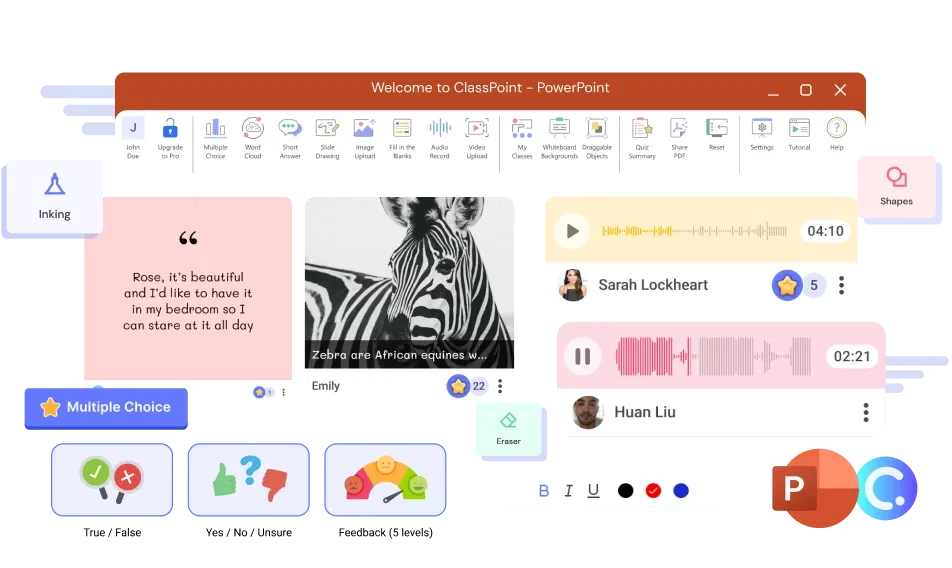
In the long run, using ClassPoint in PowerPoint may be the most appropriate method for daily usage since you’d need to switch between PowerPoint and your browser in order to use your gamification system, which can be time-consuming. Fortunately, ClassPoint provides those features from interactive quiz to gamification system – all in one tool. This tool provides us exactly what we need – a package of interactive features allowing its users to transform static PowerPoints into a live interactive presentation.
More Easy-Prep, Fun PowerPoint Games
With ClassPoint, a student engagement add-in for PowerPoint, there are plenty of other tools that you can use to turn your slides into an fun and interactive game! (that don’t include the student-response questions or the use of student devices!)
The Snowman (Originally “Hangman”)
The famous game of hangman can be easily played in PowerPoint! You just need to design the game on a slide and ClassPoint will help you to take care the rest.
Note: While “hangman” is famous, there are plenty of more politically correct versions of the same game that are more kid & school friendly, such as building a snowman!
- Slide: Pose a question or think of a vocab word and design the letter placement based on the number of letters of the answer. Alternatively, leave out the letter placement and add it live on the spot using ClassPoint’s annotation tools!
- Annotation toolbar
- Alternatively, to make a more creative and aesthetic game, you can use the Draggable Objects feature for the letters & building the snowman
How to play: Give students your question or tell them to start guessing your vocab word one letter at a time! When students start answering, you can use the annotation tools to fill in correct letters, to mark down incorrectly guessed letters, and with each correct answer, you can allow your students to draw one part of the snowman on the slide, or you can help your students to draw it. If you use Draggable Objects, you can alternatively drag the correct letters to the correct spot of answer, then drag the pre-made snowman’s parts to build a complete snowman!
Tip : Plan to play this game more then once? Save your game slide design as a ClassPoint whiteboard slide, then whenever you have 5 minutes at the end of class, open this game as a whiteboard inside any PowerPoint deck ! And wah lah! You have an educational fun game and zero wasted time.
Similar to the original Jeopardy TV gameshow, you can also set up a Jeopardy game inside PowerPoint!
- Slide: Create a table grid of hidden questions behind tiles/squares. Across the top should be different question categories, and going down should be a varying range of question difficulty. On top of the question tiles/squares, instead of posing the correspondent amount of cash-worth for each question, replace it with the number of stars awarding once respondent give the correct answer. Then write your questions on each corresponding slide. You can add interactive question type in these question slides to engage your students better. Remember that the higher number of stars, trickier the question should be.
- PowerPoint animation to move away the question tiles once it’s clicked
- Or, you can use ClassPoint Draggable Objects to drag and drop the award-worth tiles
How to play: Student gets to choose their hidden question based on the category and difficulty/number of stars. Then, move the stared question tile with drag and drop or animation, revealing the question. The student or team then answers it, and if the response is correct, he/she can receive the number of stars correspondent to that question using your own tally or ClassPoint’s star reward system! (see 3 & 4 under interactive PowerPoint game!)
Wheel of Fortune
Let’s add some little fun when asking your students to contribute their thoughts in the lesson!
- Slide: First, you need to come up with a question that allows your participants to answer using a keyword or a short sentence. Then, on the slide, prepare a crossword corresponding to the correct answer of question.
- Saved Class
- Wheel of Names
How to play: In wheel of fortune, the values of the prize are cash, but for this game, we will make the prizes the number of stars students can earn for each question! To prepare the spinning wheel of names embedded into PowerPoint , you will need to first add the list of awards (stars value) for students as a saved class in PowerPoint. Then, in slideshow mode, you can show this wheel to host the famous Wheel of Fortune gameshow in your class.
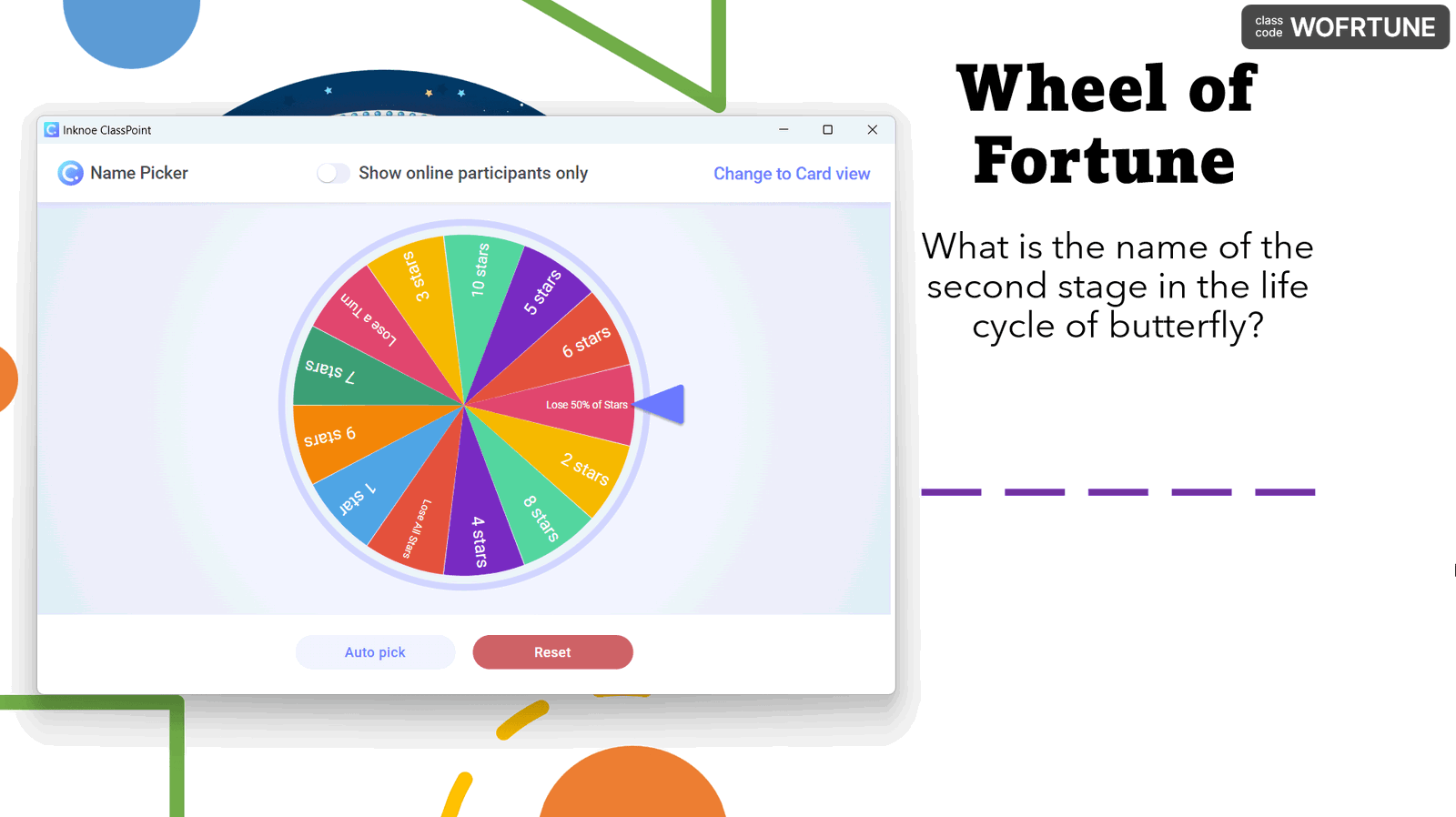
Finding the Way – Maze in PowerPoint
Last but not least, I had to include this all-time game that is loved by not just kids but also adults. With a little twist, we can turn the child game version of Maze or “Finding the Way” to an educational version of it.
- Slide: Prepare the maze image and the elements for the connection of finding the way. Note: This game fits best with the type of knowledge or definition that has correlations (e.g. Water and its states)
- Annotation toolset
- Or, Slide Drawing interactive question type
How to play: After setting up the slides, you can allow students to come up and draw on the slides from your device using annotation tools of ClassPoint in slideshow. Alternatively, you can use the interactive activity “Slide Drawing” and allow your students to draw the connection on their own device.
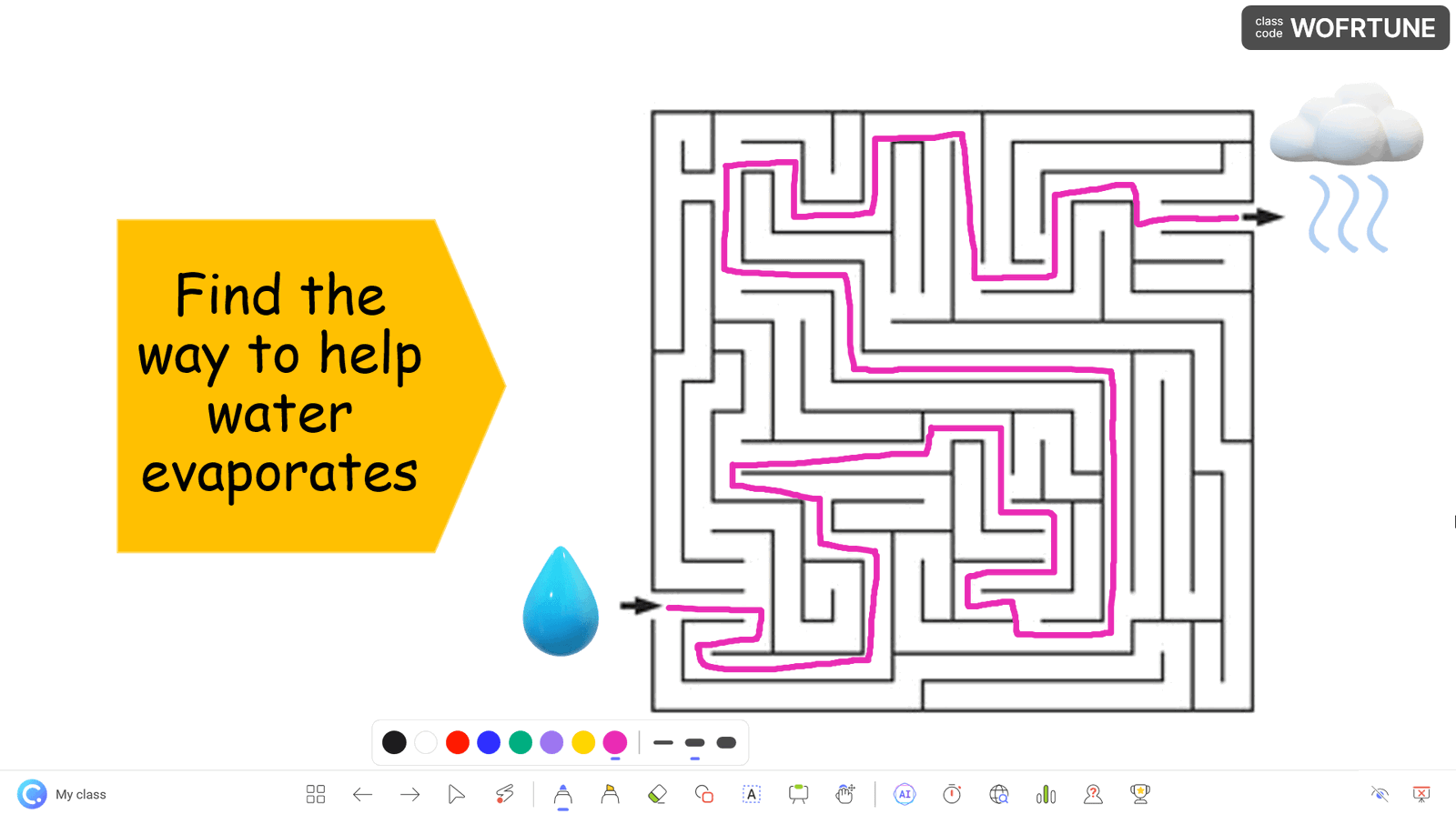
I hope that this article helps to knock on your creativity in making exceptional PowerPoint games and adopting educational gamification to your class on a daily basis. Gamification is definitely a game-changer for all educators who understand the concept and apply it in students learning appropriately.
And with ClassPoint, you can incorporate gamification seamlessly into your PowerPoint lessons! With the ability to transform slides into questions, run quizzes with students’ devices, award stars for answers, and reveal leaderboards, ClassPoint offers a comprehensive solution for creating interactive quizzes and games within PowerPoint presentations.
So, if you haven’t tried it yet, download it for free today, and share any of your own ideas or experiences using PowerPoint for games in the comment section below!
About Sylvia Nguyen
Try classpoint for free.
All-in-one teaching and student engagement in PowerPoint.
Supercharge your PowerPoint. Start today.
800,000+ people like you use ClassPoint to boost student engagement in PowerPoint presentations.

50+ PowerPoint Game Ideas for Interactive & Engaging Presentations
Last updated on May 8th, 2024

In the ever-evolving world of presentation tools, PowerPoint remains a versatile mainstay. While most of us associate it with business meetings or academic lectures, it’s worth noting that its capabilities stretch far beyond. From engaging classroom activities to lively party games, PowerPoint offers a plethora of interactive opportunities. Dive into this curated list of popular games you can craft using PowerPoint, and discover how to transform this presentation platform into an entertaining gaming console.
Benefits of using Games in PowerPoint Presentations?
Games are not just a source of entertainment; they are a potent tool for fostering engagement, boosting retention, and breaking the monotony of standard presentations.
In business, using PowerPoint games can invigorate team meetings, encourage participation in training sessions, and enhance the assimilation of complex data, making information dissemination more impactful.
For the classroom setting, PowerPoint games pave the way for an interactive learning environment, where students are motivated to participate actively. It aids in the comprehension of challenging concepts, fosters a competitive yet collaborative spirit, and ensures that learning is not just effective but enjoyable.
Leveraging the power of games in PowerPoint presentations is thus a strategic move, transforming the traditional slide-based discourse into an interactive experience for both corporate and educational realms.
In this article, we will present some game ideas that you can implement in PowerPoint, either by using pre-defined Game templates or creating your own interactive PowerPoint games. Let’s see some ideas below, as well as a quick description on how you can create the game using PowerPoint slides or download pre-existing free PowerPoint templates with games .
1. Family Feud PowerPoint Game
Family Feud is a quiz game where contestants guess the most popular answers to survey questions.
To create this game in PowerPoint, design slides with the questions and use animations to reveal the answers as players guess. Organize the answers in a descending order of popularity, revealing the most popular answers last for dramatic effect. Color coding and use of sound effects can enhance the experience. You can download this free Family Feud PowerPoint template .

2. Jeopardy PowerPoint Game
Jeopardy is a classic quiz game featuring categories and increasing point values.
To create a Jeopardy Game in PowerPoint, begin by crafting a grid of point values on a master slide. Each value should link to a separate question slide. Use hyperlinks for seamless navigation. After answering, guide the user back to the main grid. To track answered questions, you might consider changing the color or appearance of clicked values.
Check out this animated Jeopardy PowerPoint Template in case you are interested in learning how to make a Jeopardy game on PowerPoint.
3. Who Wants to Be a Millionaire PowerPoint Template Game
Who Wants to Be a Millionaire is a high-stakes quiz game with questions of increasing difficulty and lifelines.
To create a Who Wants to Be a Millionaire game in PowerPoint, create a series of slides with questions and multiple-choice answers. Use animations and slide transitions for lifelines, such as “50:50,” revealing the correct answer or polling the audience. Include dramatic sound effects and visual cues for milestones in prize money.

4. Wheel of Fortune Game for PowerPoint
The Wheel of Fortune is a word puzzle game, Wheel of Fortune sees players guessing letters to complete a phrase.
To create this game as a PPT presentation, you can use text boxes in PowerPoint for the puzzle, and animations to reveal letters as they’re guessed. You can also use editable puzzle templates to form the different shapes and layouts. Consider incorporating a spinning wheel animation or image for added effect. Sound effects can be used when letters are guessed correctly or incorrectly.

5. Bingo Game for PowerPoint
Bingo involves players marking off numbers on a card as they’re randomly drawn.
To create a Bingo Game in PowerPpoint, prepare Bingo cards and design slides that randomly display numbers. To ensure randomness, consider using a number generator and manually progressing through slides.
6. Memory Match Game in PowerPoint
Memory Match game is a card-matching game. Memory Match requires players to flip two cards to find pairs.
Using PowerPoint, design slides with hidden images or text that appear upon click. Ensure two of each item for pairing. Create a grid layout in PowerPoint, and use PowerPoint animations to simulate the card “flip” effect when clicked.
7. Trivia Quiz Game in PowerPoint
In Trivia Quiz, players answer a variety of multiple-choice or true/false questions.
Design your PowerPoint slides with a question on top, followed by clickable answers below. Using slide transitions, provide immediate feedback for correct or incorrect answers. Consider incorporating a scoring system or timer for added challenge. If you don’t want to create a quiz from scratch, you may use a free Quiz PowerPoint template design , or a free Trivia PowerPoint template , with pre-defined slides prepared for a Quiz or Trivia game. Alternatively, you can check the quiz maker tools .
8. Hangman PowerPoint Game
Hangman is a word-guessing game. Incorrect guesses lead to drawing parts of a hangman figure.
For this game in PowerPoint, you can create a new PowerPoint presentation and use text boxes for the mystery word. Then, add shapes for the hangman drawing, revealing parts incrementally with each wrong guess. The game concludes when the word is guessed or the hangman is fully drawn. You can also leverage this presentation by applying animations.
9. Pictionary PowerPoint Game
Pictionary is about guessing a word based on a drawing.
In PowerPoint, you can create a Pictionary game that displays a hint or a drawn representation of the word on a slide. When presenting the slideshow, players then guess what the word is based on the visual. This can be made interactive by using drawing tools in real-time, if the platform allows.
10. Price is Right in PowerPoint
In this game, players estimate the price of various items.
To create a Price is Right PPT presentation, you can showcase images of items on your PowerPoint slides and have players guess their price. Once guesses are made, reveal the actual cost. This can be done using PowerPoint animations (first the cost is hidden, and then when revealed you use a Fade effect or any other animation under the Appear section). To add more dynamics, use animations to simulate the spinning wheel or other mini-games from the show.
The Big List of Other Interactive PowerPoint Games for Engaging Presentations
Here are 40+ interactive PowerPoint games that you can incorporate into your presentations for engaging presentations.
Conclusions
PowerPoint proves time and again that it’s more than just a tool for slideshows; it’s a canvas for creativity. By thinking outside the box, we can leverage its features to create engaging and interactive games suitable for various settings. Whether you’re an educator aiming to make lessons more captivating or someone looking to add a fun twist to a gathering, these PowerPoint games offer an innovative way to engage and entertain. So, the next time you open up PowerPoint, challenge yourself to see it not just as a presentation tool, but as a gateway to interactive fun.
Leave a Comment Cancel reply
Your email address will not be published. Required fields are marked *
Save my name, email, and website in this browser for the next time I comment.
Sign up to our newsletter
We will send you our curated collections to your email weekly. No spam, promise!
- Editor's Choice: Back-to-School Tech Gifts
- Get These 12 Student Discounts!
10 Free PowerPoint Game Templates
Customizable slideshows for Jeopardy, Deal or No Deal, and other games
:max_bytes(150000):strip_icc():format(webp)/stacy-fisher-9842c081a15b4def99bfd26b4822be19.jpg)
- Emporia State University
:max_bytes(150000):strip_icc():format(webp)/Lisa_Mildon-1500x1500-4f77d70e45154ae7ada946d2c35ec60d.jpg)
- Southern New Hampshire University
PowerPoint templates are a great way to introduce a new unit or review for a test with your students. It's a break from the regular routine, and students love the teamwork and competitiveness.
I've also used these templates with friends. I can replace the questions and answers with fun topics we're all familiar with and then play in person or online over a video call.
There are lots of websites with free PowerPoint templates that work with Microsoft's software and free presentation programs .
Jeopardy PowerPoint Templates
Most of the hard work is done for you.
Sleek graphics.
Some come with familiar sound effects and theme song.
Some are in the HTML format only.
A few require your email address.
One of the most popular types of PowerPoint games to use in the classroom is Jeopardy. It's a great game to use to review for a test or to introduce new material to students. They can be played as a class, teams, or individually on computers.
Family Feud PowerPoint Templates
Can encourage and be used with teams of students.
Great graphics resembling the TV gameshow.
Realistic sound effects from the gameshow.
Some are limited to a few slides.
Some require quite a bit of customizing.
Not much non-English support.
Some don't come in the popular PPTX format.
Another free game that's popular with teachers and students is Family Feud. These are played just like traditional Family Feud, and kids of all ages really get into the game.
Wheel of Fortune From Games by Tim
Comes with great instructions for setup.
Realistic looking graphics.
Website has handy instructional video for help.
Cool animation.
Setup is pretty involved.
Doesn't automatically figure dollar amounts.
Can load only 12 puzzles.
Spin the wheel, use your own puzzles, and track scores with this Wheel of Fortune PowerPoint template that really reminds me of the actual game. It comes in the PPTM format .
Only Connect From Fisher Huntz
Includes sounds.
Multiple templates with questions and answers.
Includes a blank template.
Provides directions for playing and editing the template.
Doesn't include the game's Connecting Wall.
More free PowerPoint templates are available here that are modeled after the game Only Connect. One template is basically blank, so you can fill it out with whatever you want. Each of the others have 20 prefilled questions and answers that are ready to go for any teacher looking to entertain their kids with math or science related questions.
Deal or No Deal From Mining Quiz
Included a game rules slide for players.
Has a small help page to assist in setup.
Easy to edit template.
Graphics are a bit simple.
Single sound effect isn't clear.
This Deal or No Deal PPTX template is easy to manipulate and has sounds for each time you choose a briefcase.
Who Wants to Be a Millionaire Verbs
Comes with 12 pre-made questions.
Graphics and text are easy to read.
Added sound effects to enhance gameplay.
Will need to change the money values for other countries.
The lifelines are not clickable and only advance the slide.
Doesn't accurately keep track of winnings.
This Who Wants to Be a Millionaire template has questions already filled out for you about simple verbs. There are 12 questions in total, and I like that it has sounds and animated graphics for realism.
Who Wants to Be a Millionaire Templates From Sctriton Science
Website provides optional sound effects.
Provides enough blank question templates to play a full game.
Sound effects add some excitement.
The lifeline links reveal all answers.
Sound snips aren't very high quality.
This is yet another template for playing Who Wants to Be a Millionaire in PowerPoint. It has 15 questions, all blank and ready for you to fill out with your own information.
Cash Cab From Sctriton Science
Provides enough slides to play an entire game.
Gives basic game instructions.
Fun ceiling animation like the TV show.
Can easily edit it.
Sometimes the template messes up.
Just like in the real game, this template includes not only blank slides for all the different questions, but also a place for a Red Light Challenge and a Video Bonus Question. You can also download the audio files for this template.
Cash Cab First Aid From Mining Quiz
Gives clear instructions on how to customize.
Nice sound effects to engage player.
Text is easily readable at a distance.
Distracting background.
No extra rounds like actual the actual game.
No way for player to select answer.
This Cash Cab template for PowerPoint has 12 questions, all related to first aid information. This template revolves around the objective to reach the Empire State Building before being kicked out of the cab with too many wrong answers.
You can also grab a blank template from the same download page if you want to write in all the questions and answers yourself.
The Price is Right by Stranded Goose
Works for free through Google Slides.
Very simple design.
Must make a TPT account if you don't already have one.
TPT requires access to your whole Google Drive account.
This 22-page template for The Price is Right is from a user called Stranded Goose at Teachers Pay Teachers. It works in Google Slides , so you'll use the presentation as part of your Google account.
Get the Latest Tech News Delivered Every Day
- 13 Free PowerPoint Game Templates
- What Is Microsoft PowerPoint?
- 10 Best Places for Free PowerPoint Templates
- Create a Default Presentation Template in PowerPoint
- What Is Microsoft PowerPoint and How Do I Use It?
- How to Get PowerPoint on a Mac
- How to Create a Timeline in PowerPoint
- The 8 Best Free PowerPoint Alternatives
- 5 Best Free PowerPoint Background Sites
- Change the Default Font in PowerPoint Text Boxes
- How to Make a Word Cloud in PowerPoint
- How to Create a Microsoft Sway Presentation
- How to Copy a PowerPoint Design Template to Another Presentation
- How to Use Microsoft's Free PowerPoint Viewers
- The Definition of a Slide (or Slides) in a PowerPoint Presentation
- Use This PowerPoint Template for a Multiple Choice Quiz

- What solution is best for me?
- Download the Government eBook

13 Interactive Presentation Ideas to Engage Students in Class
If you’re a teacher, you’ll know that there’s a lot to think about when you’re in class. It’s important to ensure that what you’re teaching the children is as educational and as interesting as possible - with the aim of engaging the students in the subject and hopefully even enabling them to enjoy learning!
This can be a very difficult balance to strike. However, it’s made easier by these interactive presentation ideas listed in this article, which can engage even the most distracted of students!
How to display presentations
The best classroom gadget to show these presentations on is an interactive display. These are large devices that are mounted to the wall and can connect seamlessly with any video collaboration applications. You can connect interactive displays to the internet and further use them as a powerful classroom teaching tool, to help students learn in a fully interactive and efficient way. We sell interactive displays for classrooms here at Avocor.
Interactive class presentation ideas
Ice breakers.
Many work-related presentations start with an icebreaker, and there’s no reason why a presentation to a class of students should be any different.
The icebreaker question will depend on the class and age of students, but could be something like the following:
- If you could be an animal, what would it be and why?
- What would be your dream place to go on holiday?
- If you could have dinner with three historical characters, who would they be and why?
- If you could make any kind of potion, what would it do?
Incorporating video is one of the best interactive presentation ideas for students. Even if the video is about the same topic as the presentation, the fact that it’s a different type of media will interest the class.
You can either find a suitable video on YouTube or another video software or, if you have a file saved, paste it directly into the presentation .

Questions and answers
Questions and answers are a great way to get the whole class involved. You could invite one student to ask a hypothetical question about the topic, and another could answer.
For example, if you’re learning about Henry VIII and his six wives , you could ask a student to ask a question about them. Their question could be “what was Henry VIII’s favourite food?” or something similar.
When another student answers, you could ask them to explain their answer - for example, if they say “meat and bread”, they might carry on to explain that that was the main diet for royalty at the time.
Songs are a good way to interest younger kids in a topic. You can find songs about all sorts of subjects on YouTube. For example, this seven continents song could be suitable for a Geography song.
Many songs on YouTube have lyrics, so you could encourage your class to practice their reading as they sing along.
Some presentations are made more interactive by external objects - and if you want to engage younger kids, bringing some props can really help the lesson to come alive.
For example, if you’re doing a history lesson about the Ancient Egyptians , you could bring some figures of Tutankhamun, the Sphinx and the ancient pyramids for everybody to see.
Class involvement
Asking for direct class involvement throughout the presentation is a good way to ensure that students stay engaged. For instance, if you’re doing a presentation about animals, you could ask students to make a noise every time you mention a certain animal.
You could ask them to roar each time you mention lions, or make a monkey noise each time you talk about monkeys. This is a great way to ensure that the students are paying attention!
Transitions and animations
A simple way to ensure that your students are paying attention is to use different transitions and animations throughout your presentation.
If you’re teaching older kids or teenagers, you might not want to have too many of these, but younger kids will love seeing every item bounce onto the screen. It’s a wonderful way to get them interested in technology in the classroom !
Quizzes are an effective way to engage students of any age. You can include these at the end of the presentation and they can include questions that you’ve covered in the session.
If your students know that there will be a quiz at the end of the class, they may be more likely to pay attention throughout it! You could also ensure maximum engagement by telling students that there will be prizes for the winner of the quiz - such as stickers or sweets.
Interactive games
Interactive games for class presentations are always a popular way to ensure that students stay engaged! Some examples include:
- noughts and crosses or tic tac toe
- pictionary
- hangman or an alternative like spaceman
- 21 questions
It’s best to make these games related to the subject. For example, the game “21 questions” involves you thinking of a character and students asking questions with a yes or no answer about what character you are.
If you’re teaching a history class, the character could be somebody from history (such as Florence Nightingale or Queen Victoria), or if you’re instructing a science lesson, the character could be a famous scientist (like Einstein or Steven Hawking).
Brainstorming
Brainstorming is another great way to get the class involved. You can use an interactive display to create the brainstorm diagram on. Students can take turns writing on the board, and it can securely connect to any external devices, so any remote class members can join in.
With an interactive display, you can also immediately share the diagram to the rest of the class once it’s finished, so they can keep it to refresh their knowledge of a topic.
For example, if you’re teaching your class about Australia in geography , you could ask their students what they may already know about Australia. They could come up with some items like the following:
- Sydney Opera House
- Aboriginal art
- outback
You could then create a spider diagram with different legs depending on the topic. For this list, there could be an “animals” leg for kangaroos and koalas, an “architecture” leg for the Sydney Opera House, a “landscapes” leg for the rainforest and outback, a “culture” leg for Aboriginal art and a “food” leg for BBQ.
Make a story
Making a story about the topics covered can encourage creativity around the topic. To do this, write down a couple of opening lines to a story related to the topic that you’re teaching.
For example, if you’re teaching students about the Ancient Roman Empire, you could start by saying “Ronald the Roman lived in the British City of Bath, where the Romans had arrived 20 years before. He spent most of his time at work, where he built houses for the rest of the Romans”.
Then, you could invite a student to continue the story, encouraging them to stay as on-topic as possible. You could even give out a prize to the student with the best part of the story. Depending on the size of the class, you could ask every student to contribute.
Stories also work well for English lessons. In these classes, the topic of the story doesn’t matter as much, but you could encourage students to use whatever language they’ve been learning.
For example, if your class has been focused on adjectives, you could ask students to put as many adjectives as possible in each part of their story.
Have a short play
You could take your stories to the next level by creating a short play on one of your slides. This could be based on whatever topic you’re learning about, and you could select a few students to come to the front of the class and read out the lines.
You may wish to create this personally, find a relevant play online or you could even turn a well-known story into a play!
Virtual field trip
One of the most creative interactive school presentation ideas is to take the class on a virtual field trip. This is particularly valuable for geography lessons, where you may learn about places that students might not be able to visit in person, like the Amazon rainforest or even under the sea!
You could link to Google maps, where you could use Google Earth to explore a particular area. Alternatively, there are some YouTube channels that specialise in virtual tours and field trips, such as this one which details all you need to know about rainforests .
If you have a classroom full of students and want to keep them as engaged as possible while teaching them new material, try some of these interactive games for classroom presentations and other ideas!
By incorporating some of these interactive ideas into your presentation, you’ll have the students’ full undivided attention and ensure that they not only enjoy the class but retain the information.
Related Articles
9 tips for effective interactive workplace communication, flexible working advantages: 7 key benefits for your business, how to create a flexible working environment: ultimate guide, interactive wall ideas for offices: how to decorate for inspiration, what does the future of flexibility at the workplace look like, get in touch, sign up for our newsletter.
Keep up to date with all the latest from Avocor and partners and get information on upcoming events and exciting product news.

Latest Updates
Useful links, ready to talk.
To provide the best experiences, we and our partners use technologies like cookies to store and/or access device information. Consenting to these technologies will allow us and our partners to process personal data such as browsing behavior or unique IDs on this site and show (non-) personalized ads. Not consenting or withdrawing consent, may adversely affect certain features and functions.
Click below to consent to the above or make granular choices. Your choices will be applied to this site only. You can change your settings at any time, including withdrawing your consent, by using the toggles on the Cookie Policy, or by clicking on the manage consent button at the bottom of the screen.
- Interactive Display
- Accessories
- myViewBoard
- Multi-touch Series
- Professional - VP Series
- Business - VG Series
- Home and Office - VA Series
- USB-C Series
- Home Entertainment
- Sports Viewing
- Installation
- Presentation Displays
- Direct View LED Display
- Pen Display
- ViewSonic Education Solutions
- ViewSonic Workspace Solutions
- Personal Display Solutions
- TeamJoin Meeting Solution
- ViewSonic Library & Blog
- myViewBoard Resources
- Case Studies
- Solution Briefs
- White Papers
- Press Center
- Knowledge Base
- Product Warranty
- Español ( Spanish )
- Deutsch ( German )
- Türkçe ( Turkish )
Education | Sep 21 2019
5 Interactive Presentations Ideas that will Engage Students
Interactive presentations should always be an educator’s goal. Dry, teacher-centered lectures lose students’ interest, while interactive presentations grab and hold attention. Getting students involved improves retention, understanding, and enjoyment. And it’s remarkably easy to involve the audience with just a few easy principles (especially with the right technology at your disposal).
Start creating interactive presentations with the tips and tricks below or get more insights on modern education technology.
Students today expect the classroom to be both educational and enjoyable at the same time. Interactive presentations help engage students by having them participate in the lessons instead of passively listening to lectures. This reduces boredom and gives students a sense of responsibility to be attentive.
A Gallup Poll of about 3,000 schools shows that around the 5 th grade 74% of students feel they are engaged in school, but by the 10 th , 11 th , and 12 th grade those numbers fall to the 30% range. It is important for educators from K-12 and on to higher education to recognize that keeping students engaged in the classroom is important and the adoption of interactive learning environments can be a key driver.
Millennials and Generation Y students are especially accustomed to being a part of the lessons and not just a spectator. Students are encouraged to talk and offer their ideas to create a collaborative atmosphere where both teachers and students are sources of knowledge and insight. The teacher plays more of a facilitator role in moving the lesson along and encouraging students to participate in their own learning outcomes. Students offer their own input, additional information, and give examples of how they would apply the key concepts.
The learning task is the central aspect of the interactive presentations (instead of the teacher’s energy level and hold on the students’ attention spans) and the lessons evolve around it. Even though the teacher is normally, the ‘presenter’ in most cases the ‘interaction’ part comes in a variety of ways to get students participating in the lesson. Many activities, games, role-plays, quizzes, and discussions can be integrated into the presentation flow and the lessons will take different directions from there. We will discuss later many examples of tools and techniques to encourage collaborations.
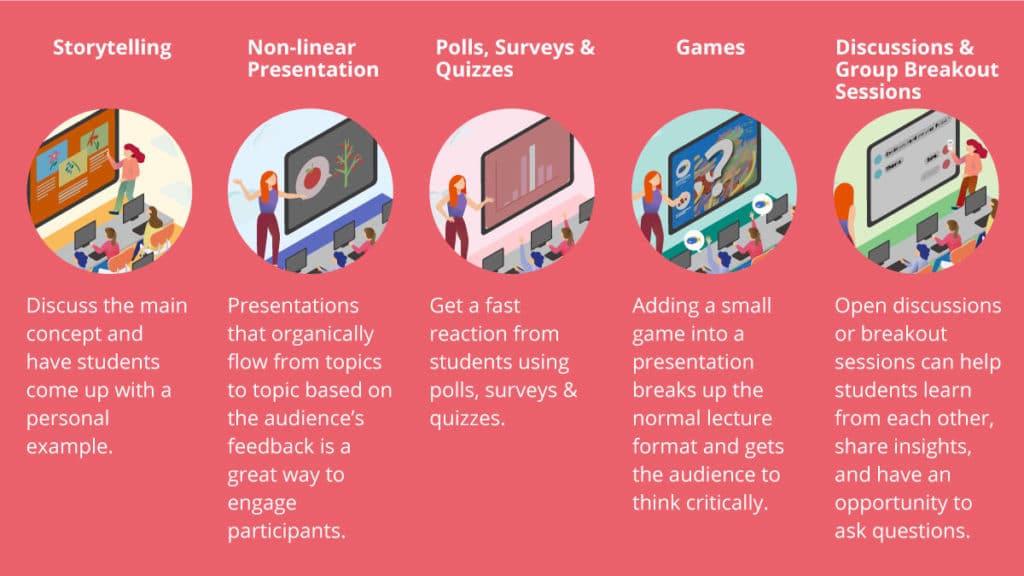
Technological Aid in Interactive Presentations
Although interactive presentations can be done without technology, it is greatly aided with the adoption of tools designed to facilitate the learning process. For example, a quiz is given in the middle of the presentation. On one side, traditionally a teacher can write the quiz before the lesson starts, print out copies for all students, pass out the quiz, and collect answers. To provide feedback for the exercise the teacher will also need to grade and start a discussion on the results before moving on to the next topic. This process is time-consuming and restrictive.
With technological aid such as an interactive digital whiteboard or a classroom quizzing application on individual devices, the students and teacher can come up with the quiz questions on the spot. This digital quiz can be administrated wirelessly to all students and within seconds, the results can be shared with all participants to discuss. This greatly increases spontaneity, variability, and class involvement.
5 Interactive Presentations Ideas and Corresponding Technology Aids
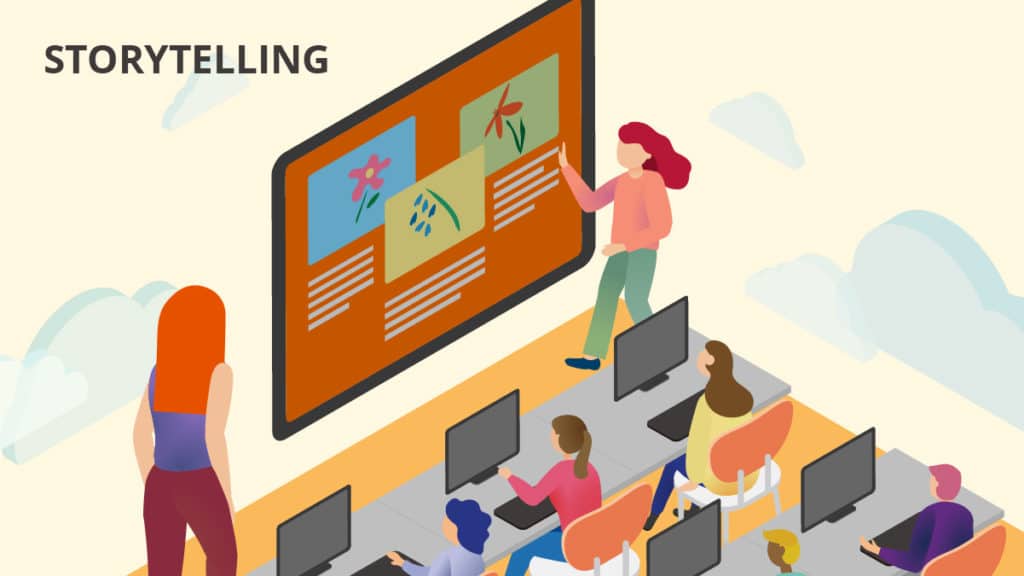
1. Storytelling
The teacher does not have to be the only star. The glory of the presentation can go to all participants who have a story to tell. The main concepts can be discussed and students should be given time to come up with a personal example. This exercise helps students relate to the subject matter and getting to listen to other students’ examples will drive home the concepts further. The need for the teacher to plan extensive examples and be the only one talking during the presentation is reduced. Teachers can also judge by the stories shared how much the students are understanding.
Storytelling with technology: Many digital whiteboards have Cast and Throw functions that will allow students to work on their own examples on their devices and send this to the whiteboard when sharing. This allows students to quickly go up and share their stories without sending files by email, wires, or USBs.

2. Non-linear presentation
Presentations that do not follow a strict order but organically flow from topic to topic based on the audience’s feedback are a great way to engage participants. Once prepared, the presenter can flow from one topic to the next by asking questions, polling, or receiving requests at the end of each key point. This allows the audience to ‘build’ their own presentation on what they want to hear not in a rigid manner as with traditional slide-based presentations.
Non-linear presentation with technology : There are non-linear presentation applications like Prezi which helps presenters build presentations on easy-to-customize templates. They offer a zoomable canvas (not slides) to help people share knowledge, stories and inspire audiences to act. The canvas shows relationships between points and offers a recommended flow but not a set path to follow.

3. Polls, surveys, and quizzes
One of the most recognizable and used tools in the classroom to get a fast reaction from students are polls, surveys & quizzes. For polls, simple questions that have limited answers are used to gather a consensus. This could be in the form of a raise of hands, ballots, or having students form groups. Surveys would require printed paper sheets with multiple choices, scales, or short answers to gather opinions. Quizzes are used to quickly test a student’s knowledge on what was just covered, so the class can identify weak areas and crystalize main concepts.
Polls, surveys, and quizzes can be anonymous or not. Openly requiring students to share their ideas on results such as a debate or open discussion would increase the interactives of the activity. Students can also be tasked to create questions and grade their own surveys and quizzes for an added layer of participation within the presentation.
Polls, surveys, and quizzes with technology : Many classroom management software such as Google Classroom has built-in tools to create polls, surveys, and quizzes along with assignments, communication, and other educational features. Once submitted, the collection and grading are instantaneous. The results can be shared easily with students both individually or as a group.
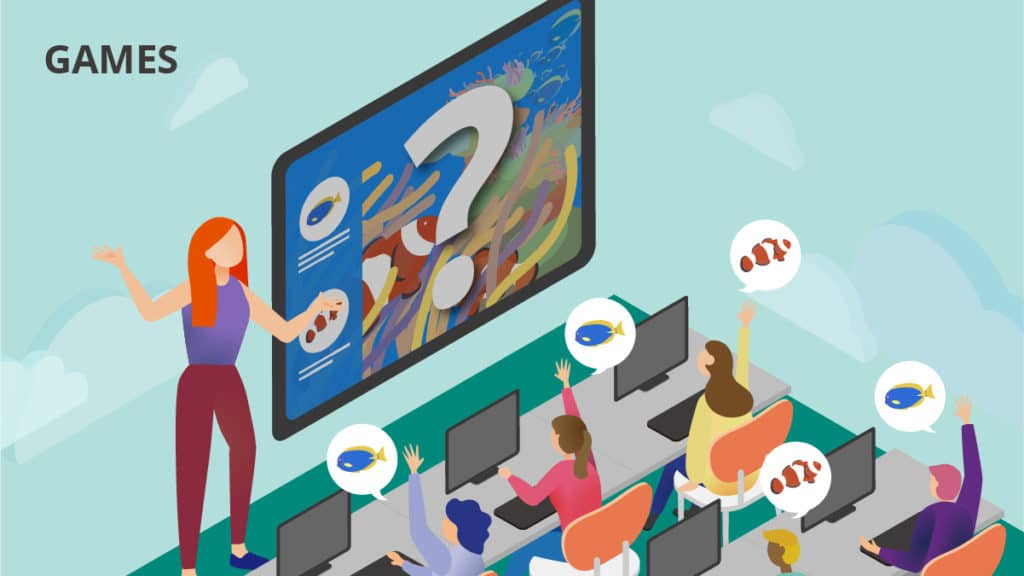
Is there a student – of any age – who does not like a good game, contest, or competition? Adding a small game into a presentation breaks up the normal lecture format and gets the audience to think critically to help their team win. There are many versions and adaptions of basic educational games . Teachers can take games such as Pictionary, Jeopardy, Casino, and Bingo then adapt them to their needs.
ViewSonic Originals
Free interactive teaching materials
Gamifying your interactive presentation : By integrating into the presentation links to applications like ClassCraft or Kahoot a teacher can quickly launch an interactive digital game. These applications help teachers tailor their own games by adding their questions, facts, and materials for individuals, small teams, or the whole class to participate.

5. Discussions and groups breakout sessions
Having the class only listen to a lecture marks the end of any interactive presentation. Adding sections where students can have an open discussion or breakout sessions can help students learn from each other, share insights, and have an opportunity to ask questions to their peers. It is also an opportunity for the teacher to take a break from talking and help small groups or students individually as the rest of the class converse.
Taking the discussion online for interactive presentations : Live discussion applications like NowComment allow students to markup and discuss a text in real-time which is great for peer-review activities and gather student input into one place quickly. Alternatively, Yo Tech is great for teachers to create and moderate real-time chat rooms. Students can send text-like messages, reply to other messages, and share pictures and drawings. Online chat groups are a great way for large groups of students to collaborate and interact in one place while keeping the noise level down in a classroom.
Tips for Creating Interactive Presentations
Here are some tips when creating a presentation that has interactive components:
Add in places within your lecture notes or presentation slides reminders for you to engage the audience. This could be a small image or phrase. When using digital whiteboards or other display technology you could also use a sound, empty slide, or pop-up link to prompt you to start.
Time Limits
It is great to keep going a good game or discussion in the class where everyone is really engaged. However, keep the maximum amount of time you can dedicate to these activities in mind. Have a watch or a timer on hand and keep things moving. Give enough time for students to get engaged without overdoing it. Spread out chances for students to talk and share. When it is time to move on to the next topic prepare a transition to the next part of the presentation.
Think of ways to let all students have a chance to share. You can select students randomly or have them take turns in some kind of order. Remind students that this is a learning activity and not everyone will get it right the first time. The interactive activity should be open and inclusive. Students who are introverted may be given activities that can be done without going to the front of the class or public speaking.
Benefits of Having Interactive Components in Your Presentation
- Retention: Actively having students engage with the concepts of the presentation in different ways and hearing it from different people (besides the teacher) helps with long-term retention.
- Personalization: Students are given the choice of where the presentation is heading and participate in their own learning outcomes.
- Fun: Having a break from the routine, getting a chance to move around, developing teams, and sharing are all much better than sitting silently and taking notes.
- Feedback: Adding interactive activities into a presentation gives you instant feedback about students’ comprehension.
- Vocalization: Having students actually vocalize their ideas helps them internalize the concepts.
- Summarization: Students review and summarize their own main points while doing the activities so there is less need for repetition.
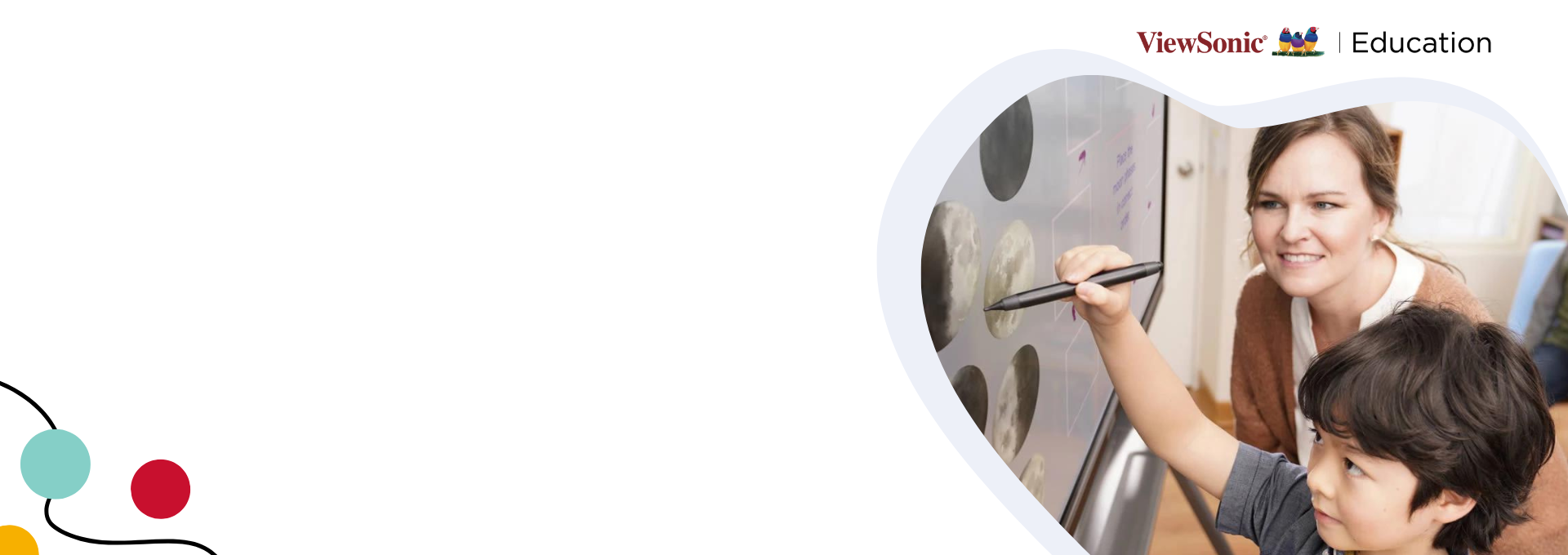
ViewSonic Education
Learning Solutions For the Future
Build Your Own Version of Interactive Presentations for Your Next Lesson
Bringing in the interactive components and increasing the engagement of your presentations will both help you – a teacher – and your students. Make presentations both educational and entertaining with Edutainment! With or without technology, consider incorporating some new ideas into your next interactive presentation.
If you liked reading this article, you might also want to explore our complete guide to technology in the classroom or gain more insights on engaging lessons with ViewSonic’s education solutions.
RELATED ARTICLES
Tech | Aug 12 2024
Strengthening Campus Safety: 3 Ways to Leverage Device Broadcasting
Discover how centralized device management systems can enhance campus safety by improving communication and emergency response times.
Technology in the Classroom | Aug 05 2024
Integrating Active Learning Spaces in Modern Classroom Design: 3 Essential Pointers
Discover how active learning spaces can transform classroom engagement and collaboration through flexible layouts and interactive tech.
Education | Jul 22 2024
Preventing Learning Loss Over Summer Break: How to Prevent the “Summer Slide” in Science
Explore fun ways to combat summer learning loss with science activities and challenges, using hands-on projects and online resources.
Technology in the Classroom | May 23 2024
Creating Modern Classrooms: 3 Contemporary Approaches to Classroom Design
Discover how modern classroom design transforms education with adaptable, inclusive, and sustainable spaces where every student can thrive.
SELECT YOUR REGION
Asia pacific & africa.
LIVE 1-HOUR CLASSES AVAILABLE
Categories:
- Storytelling
A Simple Interactive Game To Use In Your Next Presentation
Interactive presentations are superior to the static ones.
You know that too. One-way presentations, where you are the only one talking are exhausting and boring for you and your audience. I hate them…
That’s why I am always on the lookout for good interactive presentation games to incorporate into my talks. I learn these games and interactivity devices, I try them, and then I share the results with you, and hopefully, you try them as well.
The interactivity in your presentation depends on all the interactive games and devices you string throughout the talk. The more tools you know and implement, the more interactive your presentation will be. You can’t just rely on one device; you have to keep adding more to your toolbox.
The more tools you implement, the more interactive your presentation
In this blog article, you will learn a simple interactive game you can use in your next presentation.
Here is the Formula for My Favorite Presentation Game:
Question > Tease > Reveal > Discussion
Question: Before you reveal a statistic or a fact to your audience, ask them to see if they know it and have them guess the correct answer.
For example: – Instead of saying “the attention of span of a human being is 8 seconds.”
Ask your audience “what do you think the attention span of a person is in 2015?”
– Instead of saying “the number one reason employees leave a job is because of a manager.”
Ask your audience “what do you think is the number one reason employees leave their jobs?”
Tease Don’t accept the first answer they give you even if it’s the correct one. Tease them for more responses and comment on the answers they give you.
The commenting can be as simple as saying “that’s close,” or you can also use funny remarks to keep your audience engaged in a lighthearted and fun atmosphere.
I experimented with the optimal number for teasing, and I found (from my experience) that three times is best. I noticed that the first 3 teases raise the energy of the room and after that, it starts to drop. I would suggest you do your test and see how that works for you.
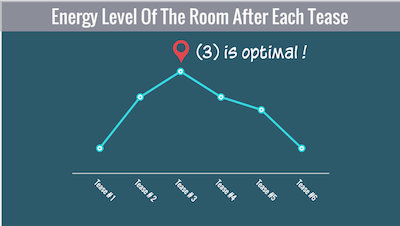
You can point to people and put them on the spot and ask them what they think or to make a guess. Once you have some answers, you can reveal the real answer.
Reveal Finally, after you hear from a few of them, you can go ahead and tell the answer. Note that this could be a response that they shouted out already. That’s fine, just tell those people that they were right or close.
Discussion Usually, the game is played to get people engaged and enrolled in the conversation. Once you achieve that, then you can go ahead and make your points.
Game in action:
Question: Me: what do you think the attention span of a human being is in 2015? (asking the group)
Tease: Me: Mark, what do you think? (I single out Mark if no one shouts an answer) Mark: 3 seconds Me: Ok higher Me: Jennifer, what do you think? Jennifer: 7 seconds Me: we are getting close, last one, Mike what do you think? Mike: 10 seconds
Reveal Me: Close, it’s 8 seconds. It’s less than the attention span of a Goldfish !
Discussion There are two reasons to why I am sharing this piece of information with you about attention spans. The first is that I want you to add more engagement devices to your presentations so that you can keep grabbing the attention of your audience.
Second, when you see an audience member’s eyes glaze over, don’t take it personally. They will tend to check out briefly every 8 seconds, and it’s usually not because of your presentation. Your job is to keep bringing them back to you 🙂
The interactivity in your presentation depends on you applying multiple games and formulas like this one. The more tools you know and implement, the more interactive your presentation will be. I hope this tool will make your list.
Let me know what you think in the comments below . If you have one or few interactive games you would like to share, please share it – I would love to hear from you.
Related article:
9 Ways To Turn a Boring Topic Into An Engaging Presentation
How To Copy The Public Speaking Masters
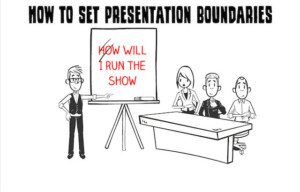
Take a Presentation From Good To Great By Setting Boundaries
Three things that erode your speaking confidence.
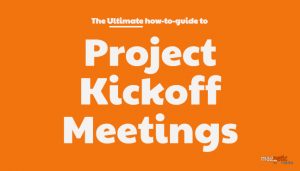
How to Run a Project Kickoff Meeting Successfully
10 interactive presentation ideas that leave a lasting impression

Attention is the gatekeeper of our memories. If you can’t get the audience to sit up and pay attention, your presentation will soon be forgotten.
In her webinar, Using neuroscience to create presentations with lasting impact , Dr. Carmen Simon, cognitive scientist and founder of Memzy , emphasized the importance of attention when forming new memories. According to Simon, one of the best ways to win attention is to insert a “cut” every three minutes.
Attention is definitely mandatory to people remembering the right things, and not just random things.
“Cuts” are simply a break from your normal presenting style, such as switching from a lecture to a Q&A or trivia question. Switching styles this ways keeps the audience intrigued about what comes next. Below are 10 interactive presentation ideas you can use as “cuts” in your own presentations.
Some of these ideas rely on Poll Everywhere, a live audience response system that lets you ask the audience a question and show live results. Try it out by signing up for a free account today.
Warm up the audience with an interactive icebreaker
Signal to the audience that this will be an interactive presentation by opening with an easy icebreaker. Kick it off before your presentation starts, as people are finding their seats, to get everyone familiar with the ins and outs of Poll Everywhere in a low-stakes setting.
Doing so speeds up the time it takes to complete subsequent activities because the audience will expect them. They’re also more likely to engage with you on Poll Everywhere if they’re already comfortable with the process.
Icebreakers come in many styles , but one of the most popular among Poll Everywhere users is the word cloud. Choose a question that calls for a personal response – What’s your favorite food? – that everyone can answer.

Plant engaged audience members ahead of time
This isn’t as sneaky as it sounds.
Sometimes all it takes is a few engaged people in the audience to get the discussion flowing, and give other people the courage to contribute. But what if you can’t count on your attendees to speak up on their own?
Ahead of your presentation, ask a few audience members who you already know and trust to pose specific questions during your presentation.
Maybe you want them to chime in with an easy “gimme” to kick things off and encourage that level of engagement. Or, maybe you want your designated attendee to ask a question that everybody else may be too afraid to ask (i.e. “How do we know we can trust this data?”).
This strategy won’t be necessary for every presentation. But when you’re worried that your request for questions will be met with lowered heads and shifting glances, this is an effective way to get the ball rolling.

Read more: From classroom to boardroom: A high school teacher’s presentation tips
Repeatedly ask questions to build involvement
You can’t expect your audience to engage and interact with you if you don’t give them an opportunity. So, make sure to have plenty of spots throughout your presentation where you can pause and ask a question.
This doesn’t need to be a threatening, pop quiz-style way to scare your audience into paying attention. Even the simplest questions can make people feel a little more involved in what you’re presenting. Think of things like:
- Have you heard of this before?
- Can you read what’s on that slide for me?
- Does anybody know where/what [thing] is?
They’re straightforward questions that require a one-word answer or super easy response, yet they do the job of reminding your audience that you’re talking with them – and not just at them.
Get people moving and out of their seats
It’s time to get your audience’s blood pumping. No, you don’t need to have them do jumping jacks or pushups, but think of some creative ways that you can get them moving around a little bit.
It could be something as simple as asking people to stand up, rather than requesting a show of hands. Or, you could think of some ways to incorporate movement with the content of your presentation. For example, have them walk up and introduce themselves to somebody new to implement the elevator pitch techniques you just taught them.
Give some thought to the different ways you could get your audience out of their seats at a few different points throughout your presentation. If nothing else, you can rest assured that they’re awake.

Read more: 8 interactive presentation games for large teams
Use interactive questions to assess the audience
If you want to know if the audience really understands what you’re presenting, ask.
Christopher Robertson , who teaches at University of Arizona’s James. E. Rogers College of Law, uses Poll Everywhere to identify and resolve any misunderstandings his students have about the complexities of law.
“Law students can easily go an entire semester passively attending class and both the professor and student discover on the final exam that they have not grasped the concepts covered in class,” said Robertson.
I find polling in class encourages active student participation and uncovers misunderstanding of how to apply the law that warrant a second look.
Taking time to test the audience this way gives them a chance to reflect on what you told them, and apply that knowledge on the spot. This can improve the chances they’ll remember that information after your presentation ends.
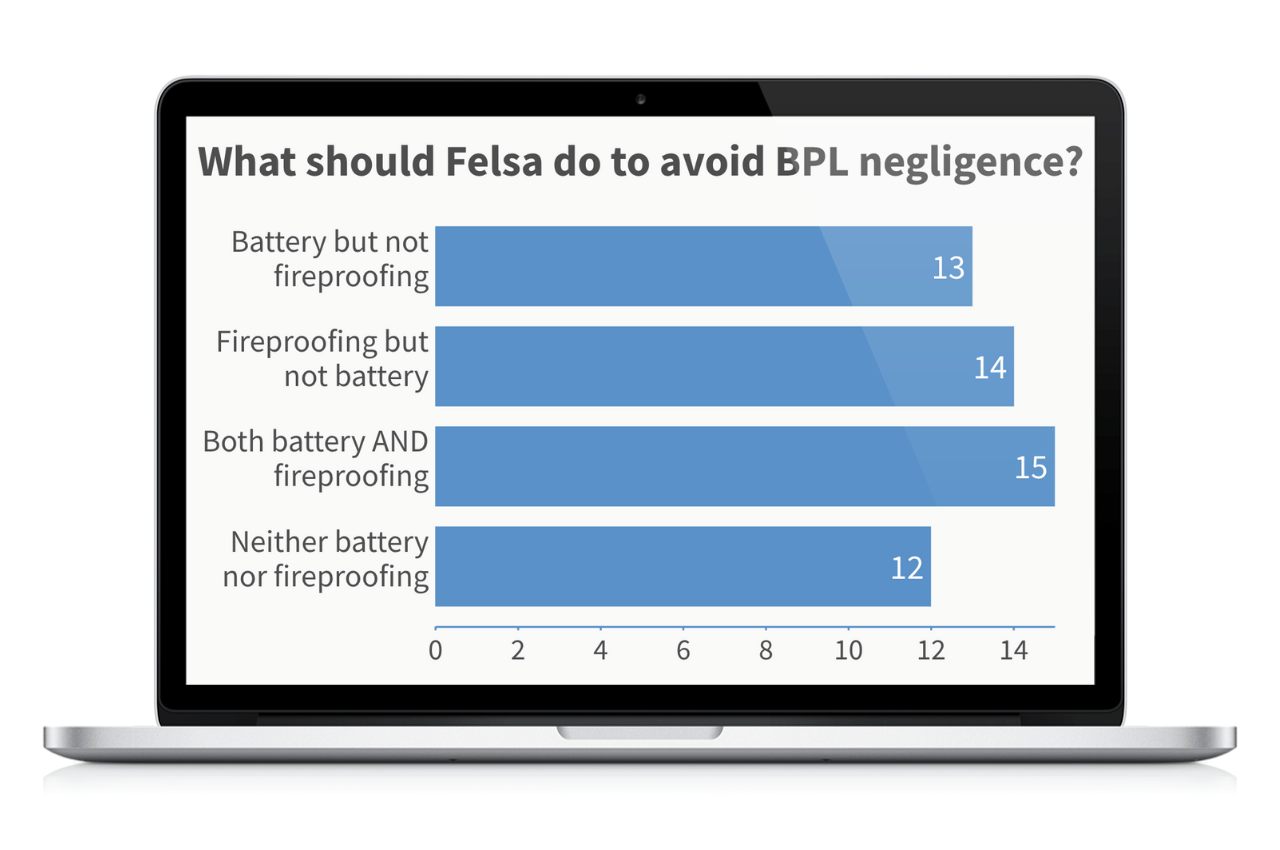
Enable anonymity to encourage candid feedback
Dr. Mark, physician and author of The Productive Physician , uses anonymous polling in his medical classes. He cites how this extra layer of security helps put students’ minds at ease, and lets them focus on the lesson instead of worrying about scrutiny from their peers.
“Poll Everywhere allows both anonymous and signed-in polling,” explained Dr. Mark, “but I prefer to use the anonymous mode as I feel it increases learner psychological safety: my students might be more inclined to test their knowledge without the fear of being seen to be wrong in front of their peers.”
You can enable anonymity for all Poll Everywhere activity types. The audience responds from the privacy of their phones – not in front of their peers – giving everyone an equal opportunity to make their voice heard.

Split your audience into smaller discussion groups
There’s nothing worse than explicitly asking your audience to engage with you and being met with only crickets and blank stares.
But, here’s the thing: Not everybody is comfortable speaking up in front of a crowd.
For that reason, it can be smart to divide your audience into smaller groups to discuss something relevant to your presentation topic – even if it’s just for five minutes.
If you want the whole audience to come back together and share what they learned during those conversations, it’s likely that a spokesperson will naturally arise from each group; meaning the people who aren’t comfortable chiming in on a large scale don’t have to.
The best thing about this strategy? The previously-reserved attendees will have a little more confidence to speak up when they know the rest of their group is there to jump in if needed.

Read more: How to present an effective PowerPoint presentation
Encourage questions throughout your presentation
It’s natural to want your audience to hold on to all of their questions until a Q&A portion at the conclusion of your talk. However, that’s pretty much the exact opposite of an interactive presentation.
Instead, be upfront at the beginning of your presentation that you want people to chime in with thoughts or questions, rather than biting their tongue until the very end. Of course, you’ll need to be willing to step in and get things back on track if a question steers the conversation too far off course.
If you don’t want the interruptions, find a way for people to submit questions asynchronously , such as in a chat window or shared document. You can respond to those submissions at your own pace throughout the presentation.
Either way, encouraging people to contribute to the topic in real-time is far more interactive and engaging than forcing them to sit and wait until the end.

Let the audience decide what’s next
Presentations don’t always need to flow in a straight line. With a quick question, you can empower your audience and let them decide what to learn about next.
Poll Everywhere’s own Katie Wilson gave a webinar on this very topic. In it, she explained how corporate trainers use polling to create choose-your-own-adventure style presentations .
Present your audience with a multiple choice activity, and let their votes determine which topic you tackle next. In Katie’s example, a corporate trainer is asking about how best to respond to a customer complaint.
Three options are available, and the audience votes on which one they think is most appropriate. Once the results are in, the presenter navigates to the slide associated with that option and discusses the results.
Use surveys to extend interaction after your presentation ends
Audience interaction doesn’t have to end with the presentation.
Jez Wiles, lecturer at the London College of Music, continues the conversation with his students both before and after his lectures with online questionnaires.
“Getting [students] to use a survey as a post-class reflective tool, or pre-lecture poll to find out what they know about something…this has all extended the use of [Poll Everywhere] for me, and boosted engagement,” said Wiles.
Poll Everywhere surveys can include any type of activity – from multiple choice to open-ended – and can be completed asynchronously at the audience’s own pace. This is a great way to help reinforce the topics of your presentation, or to collect audience feedback on the presentation itself.
I like the sense of fun Poll Everywhere naturally brings. I always find engagement goes up when I use it.
These are just some of the ways the Poll Everywhere community uses live audience engagement to drive interactive presentations. Each of these ideas is a type of cut you can use to keep your audience alert and engaged with what you’re saying.
Related articles
50+ Fun Icebreakers For Your Next Presentation

If you’re looking for the perfect icebreaker to open your presentation and connect with your audience from the get-go, look no further! With the help of our presentation experts here at 24Slides, we have compiled the ultimate list of icebreakers you can use in your next presentation, meeting, or conference.
We’ll also go through some quick icebreakers 101, solving questions like:
What is an icebreaker?
- Why should I start my presentation with an icebreaker?
- What makes a good icebreaker for presentations?
And, of course, you’ll get our compilation of over 50 icebreaker examples for your next presentation. Since there’s no one-size-fits-all, we’ve divided our presentation ice breakers into categories depending on the context of your presentation, so you can go straight to the ones that will work the best for you!
In this article, you’ll find:
Icebreakers for one-on-one presentations
Icebreakers for small group presentations (2-10 people), icebreakers for medium group presentations (11-30 people), icebreakers for large groups (31+ people), icebreakers for business and sales presentations, icebreaker ideas for training sessions and workshops.
- Virtual presentations icebreakers
- Fun icebreaker examples for playful presentations
- Great simple icebreaker questions
So, are you ready to become an expert in using icebreakers in your presentations?

Imagine you’re in a room with a bunch of people where you know only a few of them or even none at all. You’d probably start feeling awkward and self-conscious, uncertain to interact with those around you. When you’re uncomfortable, your attention will probably be divided between wanting to listen to the speaker and making sure your elbows don’t touch your unknown neighbor.
And, if you’re the speaker, you might feel pretty awkward too. Speaking in front of an audience is never easy, and you might wonder how to approach your presentation’s topic, especially if it’s dense or very important.
An icebreaker is precisely what its name suggests: it breaks the ‘ice’ of uncomfortableness between you and everyone else around you. Icebreakers are usually short activities meant to help your audience to connect first as people before approaching your presentation’s topic - making your audience more relaxed and likely to hear out your ideas.
Icebreakers can take many forms and shapes, from simple questions to engaging games. They can require people to talk with each other, answer a poll, or even move around the room. Anything that will make your attendees open up could be an icebreaker as long as it makes people feel more at ease!
Benefits of icebreakers
The main objective of using an icebreaker in a presentation is to help people get more comfortable and avoid the common awkwardness when first speaking to a new audience.
Icebreakers can accomplish many things - presenting yourself, getting people more at ease, and even as an introduction to your presentation’s topic. But they also offer a wide array of side benefits, like getting people more involved with your presentation and making it more memorable.
If you’re thinking to yourself, ‘Why should I add an icebreaker to my presentation? I’m just fine without one!’ here are 6 of the top benefits of using an icebreaker in your next meeting.
- It breaks down the awkwardness
For people who aren’t 100% an extrovert, presentations and meetings are likely to create a certain degree of awkwardness. And having a room full of people who feel uncomfortable around each other can be detrimental to your presentation. Icebreakers help lessen this feeling in your presentation – making people relax and be more at ease so they can put all their energy into listening.
- Icebreakers help people relax and have fun
When people relax, they’re more likely to entertain new ideas. An icebreaker may be the turning point to make them feel more receptive to what you’re going to say. It also opens up more possibilities for inviting your audience to participate and ask questions. Icebreakers are a great way to make them feel welcomed and more likely to volunteer or join whatever activity you’ve prepared for them onstage.
- Help you connect with your audience
A presentation where the speaker starts right away can feel a little jarring. Icebreakers are the perfect way to introduce yourself and your topic without throwing your audience headfirst into the presentation. A good icebreaker can help you connect better with your audience – making them, in turn, more likely to hear you out!
- Gives your audience an energy boost
Some presentations can feel like they take forever. When you’ve been sitting down for what seems like hours, you might feel yourself starting to nod off. An icebreaker doesn’t necessarily happen just at the start of the presentation. It can be a great way to wake up your audience after a quick break and bring them back to the topic at hand.
- Gives a chance to network with others
The right icebreaker can get your audience talking and help them find things in common. After all, your audience is all in the same meeting for a reason! By giving them the opportunity to interact with one another, you are also giving them the extra value of finding people who can work with them in the future.
And, of course, icebreakers are great ways to get the ball rolling, so by giving your audience a chance to talk with one another, you might also get more interesting and unique takes on questions and ideas later on.
- Creates a positive atmosphere
A positive atmosphere is created when people lower their barriers and defense mechanisms, making it more conducive to learning. A negative atmosphere, on the other hand, is felt when people don’t feel at ease and give their neighbors the cold shoulder. ‘Breaking the ice’ needs to get done as soon as possible!
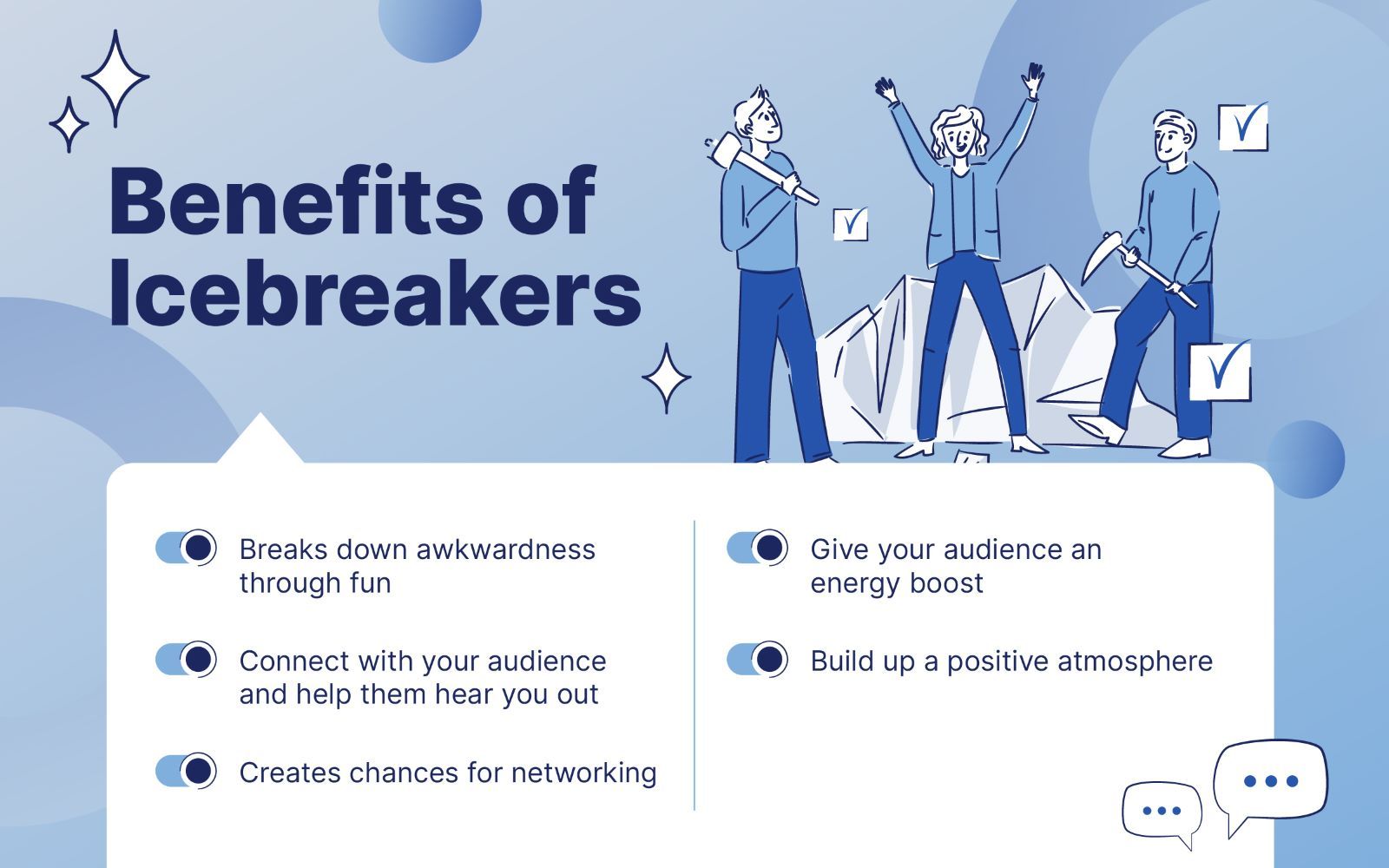
5 Practical Tips for a Good Icebreaker
What makes a good icebreaker? This is a tricky question to ask. Many icebreakers that work in certain situations will not work in others, as their use depends on context.
Here are key factors to consider when planning your next presentation’s icebreaker:
- Know your audience
Take the time to research your audience. The most important thing when planning your presentation’s icebreaker is to remind that you want your audience to feel less awkward — not more.
Taking your time to learn about the people in front of you is the easiest way to avoid doing or saying something that could potentially offend your audience. Even if you do it unintentionally, the damage will still be done.
- Identify your presentation objective
The right icebreaker will help you achieve your presentation objective, so take some extra time to think about it. For example, if you’re giving a presentation on cooperation and teamwork, you can do a game where your audience needs to rely on one another. Or conduct a poll to ask your audience how confident they are in their teamwork skills.
Making your icebreaker closely relate to your presentation’s topic will not only open up your audience but also allow you to transition smoothly to the rest of your presentation.
- Involve everyone
The icebreaker should be inclusive, meaning it shouldn’t exclude anyone from joining. For instance, if you have a disabled person in the crowd, then you wouldn’t want him or her to feel awkward for not being able to join.
Have a backup icebreaker just in case the first one excludes someone. The point is that fun icebreakers should make everyone feel more at ease — and not at the expense of the outliers of the crowd.
- Make sure you understand the context
To pick the right icebreaker for your presentation, you must know the overall setting in which it will take place. A presentation to the board of directors where you need to explain where the sales have been going down is probably not the best place to use a joke as an icebreaker. Or, if you’re giving a quick 15-minute presentation, you might not want to begin with a game that will take at least 10 of them.
Taking into consideration general setting cues like time frame, space and resources availability, and presentation tone, will help you pick the perfect icebreaker.
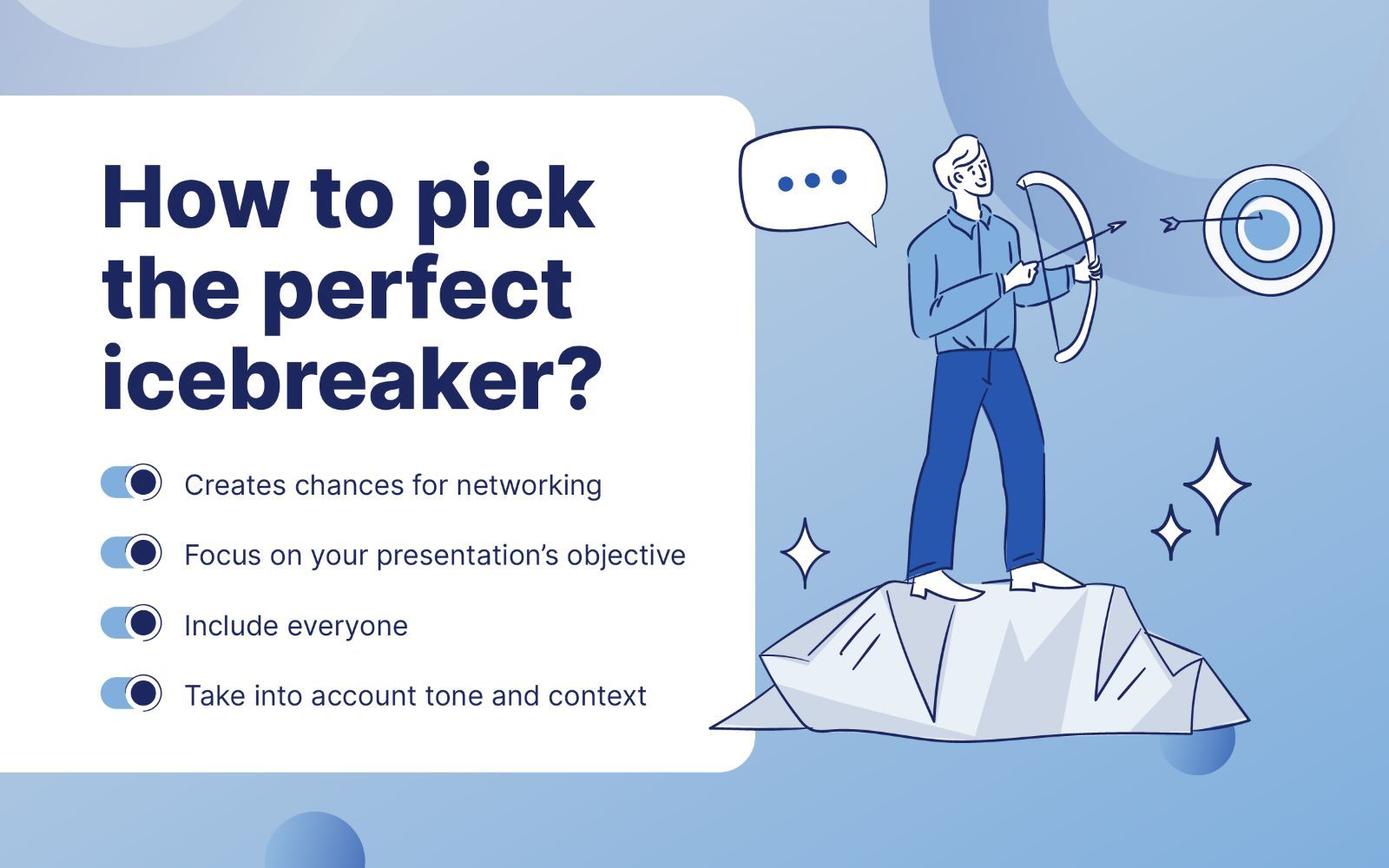
The Ultimate Presentation Icebreakers List
Here you’ll find the perfect icebreaker for your presentation. Since not every icebreaker will work on every situation, here you’ll find them divided into several categories:
- Icebreakers depending on your audience size
- Icebreakers depending on your presentation’s tone and context
- Quick and easy questions to break the ice
Do feel free to browse through the entire list: most icebreakers will be easy to adapt to fit your specific needs and your presentation!
Presentation Icebreakers for Every Audience Size
While in a small crowd, you might be able to ask person by person their input, this will most likely not be the case in large groups. On the flip side, a game that needs the audience to divide into teams might be a good pick for a medium-sized crowd, but not a one-on-one presentation.
Among the many options of icebreaker options all over the web, we’ve compiled and edited a list of which ones will work the best for each audience size:
- Introduce yourself. Unless you already know each other, introducing yourself is the easiest way to look proactive and get your presentation going. After all, it’s in your best interest for your prospect to warm up to you before your pitch or presentation!
- Have a conversation . Don’t go straight to your topic. Always warm up your prospects and engage them in conversation first. Try to ask open-ended (instead of just ‘yes’ or ‘no’) questions. You can tackle topics like current events, or even just the weather! Just talking in a more casual way will make the person feel more at ease and more likely to give you their undivided attention.
- Ask them about their personal life. If it’s someone you already know, build rapport by showing you care about them. You can ask about their kids, vacations, or even their favorite sports team. Remembering what they care about can be a huge plus when building a better atmosphere!
- Let them tell you what they expect from your presentation. It’s the easiest way to make sure you live up to your expectations! It also allows you to introduce the topics of your presentation seamlessly. Even better, you’ll feel and look more confident and under control by taking charge of the presentation’s rhythm and agenda.
- Ask something related to your presentation topic. Ask them if they know anything about your company, product, competitors, or something to that effect. It’s not only a great way to start your presentation without spending too much time on what they already know, but it’ll also help you gauge their knowledge so you can decide how in-depth you need to get in your presentation.
- Give them a small present just for showing up. Especially if the meeting is not an obligation for them, being appreciative if they show up can go a long way. After all, they’re investing their time and energy into you!
- Compliment them. It’s always nice to get compliments. But don’t overdo it, and always, always be genuine. If your prospect feels like you’re using flattery to get the sale, then it can seriously backfire on you later on. You’ll lose face and credibility.
- Introductions but with a twist. Ask everyone to introduce themselves and state something unusual or a fun fact about them. Towards the end of the presentation, ask them if they remember anything other people said during the introduction. If they get something right, reward them.
- Ask people to line up alphabetically . You can do this with their first names or last names. Or even their nicknames. This gets people talking and getting to know each other’s names.
- Charades . This is one of the best fun icebreakers on this list. It’s a party favorite but can also be used in presentations, meetings, and conferences. You probably already know how this works, but if not, here’s a funny charades video on Jimmy Fallon’s show.
- String a story together . Storytelling is a powerful element in presentations. But for this icebreaker, you’ll need everyone’s help to create a story. Start the first sentence yourself and then ask the first person in front of you to continue the story. Each person gets to decide the direction the story takes, one sentence at a time.
- Play word games . There are many different kinds of word games. But this is something you may find useful. Identify the subject or category the words should belong to, like animals or food. If the first person chooses ‘DOG,’ the next person must identify an animal that starts with the last letter of the previous word. In this case, it would be something that starts with the letter G, like GOAT.
- One word to describe him or herself . Give your audience one minute to think about the perfect word that describes them. And let the others assess if they agree with that word or not.
- Social media icebreaker . Let people open up their favorite social media accounts and then share a photo they’re most proud of. Ask them to share a line or two about why they love that photo.
- Switcheroo. Ask everyone to stand up and switch seats with the people in front of them. Do this when you notice people are starting to get drowsy and need some stimulation.
- Human bingo. This is a fun way to get to know people. Prepare the cards and the pen/pencil. The cards should already be filled out with various traits, characteristics, hobbies, etc. Then, your participants will need to go around and interview each person and check off a box that applies to them. The person who completes their card first gets a prize.
- Friendly debate. Group your participants into two. One should be the ‘pro’ group and the other is the ‘anti’ group. For instance, you can choose pizza lovers and pizza haters. Give them a few minutes to present their arguments and let the great debate begin!
- Two truths, one lie. Just like the title says, make your participants come up with 3 things about themselves, in which one of them is false. Then, in groups or pairs, the others would have to try and guess which one is the lie. It’s a great icebreaker to make your audience interact more with one another.
- Guess game. Just like the last one, it’s easier to make participants interact with one another through a game. Make everyone write on a piece of paper something fun, like an unlikely hobby or the oddest job they ever had. Your audience must try to guess who wrote which one. It’s not only a fun icebreaker, but it also helps people find out the things they have in common.
- Going to the beach. It’s an easy game, but a fun one! Each person will start by saying ‘I went to the beach and I took…’ plus an object, like a beachball, a towel, or a surfboard. Then, the next person must repeat the same sentence and add a new object to the list. The more people, the more the list will grow, and the first person who forgets an item loses! It’s also a good icebreaker for making attendees learn each other’s names by adding who brought what to part of the list they need to repeat.
- Paper planes. Make your audience write something about themselves on a piece of paper, and then instruct them to make a paper plane out of it and throw it! When they pick up a new paper plane, their goal will be to find the correct person. It’s the perfect icebreaker to get people moving and getting to know each other!
- Stretch. This one’s easy and straight to the point, but it does help break the boredom. Ask people to stand up and stretch for a few minutes. You can lead the exercise or play a short video on stage. After this short exercise, you can expect to see a bunch of awake and attentive faces.
- Treasure hunting. Hide a few prized items throughout the venue and send your participants on a treasure hunt. It’s always exciting to look out for a prize! Even better, by making them solve clues, you’d encourage your audience to work on their teamwork skills.
- Stress buster. Hand small slips of paper to everyone and ask them to write down the things that are causing them stress lately. Then, during or after the presentation, ask them to rip it to shreds.
- Snowball fight. Divide your group into two sides, and give each person 3 pieces of paper to crumple. Give them 1 or 2 minutes to try to get as many ‘snowballs’ into the other team’s side. A healthy amount of competitiveness will help you break the ice in no time!
- This or that. Another great icebreaker to highlight the things in common! Ask your audience to stand in the middle of the room, and ask them questions that will make them pick a side of the room. Things like ‘Dogs or cats?’ or ‘Night Owl or Early Bird?’ will have them jumping from one side to the other.

Icebreakers depending on your presentation’s tone
When planning your next icebreaker, you must always take into account the context of your presentation. After all, giving a sales report to your boss is not the same as giving a fun workshop on teamwork.
If you’re looking for the perfect icebreaker for a specific situation, here you might find the one you’re looking for!
If you’re looking for a more professional way to warm up your audience for your work presentations, these icebreakers are the one for you. Most business presentations are more serious and straight to the point, just like these icebreaker ideas!
- Storytelling. This one is the king of icebreakers for business presentations and for a good reason! Storytelling is an incredibly powerful tool to add to your presentations, as it helps to both exemplify your point and connect emotionally with your audience. And of course, this makes it the perfect option to break the ice and get their entire attention from the get-go.
- The highlight of the week. This icebreaker is great for getting your audience into a positive mood. When planning your next business presentation, take some extra time to find something good that happened that week or that month. Maybe you record sales for that month, or you got an exceptionally good review from a customer.
- Would you rather? When planning your sales presentation icebreaker, this one will help to get your potential customer right where you want it. Highlight the value they’ll get from your product, and how they are missing out on it. From our experience, asking, ‘What do you prefer, struggling 5 hours per week on PowerPoint, or getting your presentations done by a professional team of designers in 24 hours or less ?’ really puts things into perspective!
- Give kudos. The best way to put people in a good mood is to spread out some positivity! Giving the spotlight to someone who has done outstanding work recently can be a great way to break the ice.
- Brainstorming session. Group brainstorming is another great way to get people to exchange ideas. You hit two birds with one stone – an icebreaker and an idea generator rolled into one!
The best icebreakers for training presentations and workshops are those that incentivize teamwork and learning skills. These icebreakers will help your team get to know each other better and work together in tandem.
- Live polls. There are many apps that allow your audience to make live polls and display the results immediately. This is a great icebreaker, as it can be as serious or lighthearted as you want. You can use it to ask the audience’s mood, their favorite food, and how much they know about the topic at hand.
- Word cloud. Just like a poll, a word cloud can be a great option to explore what your audience thinks about a prompt or concept you give them and to get the ball rolling. You can make them write down in groups, have them add their ideas to a board, or even make one through an app !
- Problem-solution icebreaker. Present a real or hypothetical problem, and ask people to pitch in their solutions. You can ask them for their input individually, or you can divide them into pairs. As the saying goes, two heads are better than one.
- Finish a puzzle together. This is great for group work as everyone can contribute. For example, you can give them a few pieces each, and they’ll then work as a team to complete the puzzle.
- Pop quiz. This icebreaker is the best to keep your audience on their toes and on a learning mood. You can add it at the end of your presentation, before or after a coffee break, or even at the beginning to see how much previous knowledge your audience has.
Virtual presentation icebreakers
Not sharing a physical space can make breaking the ice even more of a challenge, especially since many icebreaker ideas would not fit an online presentation. So here you’ll find some icebreaker options that are specifically designed for virtual meetings!
- Drawing battle. You don’t have to be a professional artist to enjoy this one! There are many apps and websites that allow you to add this game to your virtual meetings. Just propose a topic and let people try to guess what one of them is drawing! You can even divide them into teams to make it more interesting.
- Try a virtual escape room. If you have time, try giving your audience this challenge to build cooperation and teamwork. It’s not only great for learning to work together but also to have fun and loosen up.
- Count till 20. Your team must try to count to 20 by shouting one number each… but without agreeing in which order they’ll go. This icebreaker will definitely make people wake up, and probably also laugh as they try to avoid talking at the same time.
- Emoji movies. Just like charades, your audience must try to guess the movie or book. But instead of someone acting, they must guess it from the emojis. It’s a great adaptation of a classic game for virtual meetings!
Fun icebreaker ideas for playful presentations
Icebreakers can also help your presentation be more playful and fun! If you like your icebreakers a little silly to make sure people loosen up their inhibitions, then take a look at these ideas.
- The no smiles challenge. If you’re making a fun, playful presentation, a great way to make it even funnier is to tell people smiling and laughing aren’t allowed in your presentation. This will most likely have the opposite effect, making people even more ready to laugh at your jokes!
- Human rock paper scissors. This is a fun, high-energy game, but may not be feasible for older participants. Check this video to see if this is something you can use in your presentation.
- GIFs mood barometer. If you want your audience to be a little bit playful, having them share their mood as a GIF is the perfect way. If you want to keep some control of what they share, you can also use a live poll to give them options to choose from. It’s the perfect lightweight activity that still gives you valuable insights into your audience and their energy levels.
- Bad jokes contest. The only thing funnier than a good joke is an extremely bad one. Have your audience try to use their best dad jokes on each other while avoiding laughing at the jokes of the rest.
10 Great Icebreaker Questions for Any Presentation
Sometimes simpler is better, and the easiest way to get people talking is to ask them to do so! These icebreaker questions will help your audience open up without taking much time or extra preparation.
- If you could have any superpower, what would it be, and what would be your superhero name?
- What's the most random piece of trivia you know and why?
- What is the oddest job you ever had, and how did you end up working there?
- If you could make a reality show, what would it be about?
- What cartoon character would you like to hang out with?
- Where is the most embarrassing place you ever fell asleep?
- If they made a sitcom about your life, what would the theme song be?
- What were the best and worst workshops/meetings/conferences you ever attended?
- If the zombie apocalypse began, what three people in this meeting would you want on your team?
- If you had to teach a class right now, what would the subject be?
As a speaker or presenter, it’s important that you prepare fun icebreakers for your audience. You want people to be comfortable not just with you, but with their neighbors and groupmates as well. The icebreakers in this list are just the tip of the iceberg concerning the wide array of possibilities you can choose from. Don’t be afraid to think outside the box and get creative with your icebreakers!
Need more time to prepare for your presentation? 24Slides has you covered!
Now that you’ve begun thinking about your presentation, and the best way to break the ice with your audience, you might wish to have more time to prepare for it. Luckily, 24Slides can help with that !
You can focus on your presentation’s content and how to make your audience as comfortable as possible, and 24Slides professional designers will tackle the visual aspects of it all. In less than 24 hours , you can get a custom-made, fully editable presentation that will wow your audience and make it even more memorable.

You might also find these articles interesting:
- 7 Essential Storytelling Techniques for Your Business Presentation
- How to Deliver the Perfect Online Presentation
- Improve Your Presentations' Body Language!
Create professional presentations online
Other people also read

6 Presentation Styles of Famous Presenters

How to create and deliver a powerful presentation introducti...

The seven worst presentations of all time and why they went ...


IMAGES
COMMENTS
Learn how to play trivia, sing and swing, 20 questions, scavenger hunt, word clouds, and more with your audience or students. These games are easy to set up, fun to play, and flexible for different presentations and audiences.
Heart, Gun, Bomb - Interactive presentation games. This one's a great game to use in the classroom, but if you're not looking for students' games for presentation, it also works wonders in a casual work setting. Heart, Gun, Bomb is a game in which teams take turns to answer questions presented in a grid. If they get an answer right, they either ...
This is just one of many ways presenters and educators use interactive presentation games to keep the audience engaged. Here are eight more ideas for your next class, workshop, or meeting. 1. Process of elimination. This presentation game for 10 or more players helps the audience get to know each other.
Creative Games for the Classroom, for your Workshop and to engage your Participants. Playing Audience Games lightens the mood, strengthens teamwork and allows for a better learning experience. ... Directly within your PowerPoint Presentation. Learn more. Try for free now. X. Top blog articles More posts. Best Sources for free Icons to use in ...
Learn how to use Google Slides to create engaging and fun games, quizzes, stories, and more for your students. From Jeopardy! to Choose Your Own Adventure, from PDF ebooks to memes, discover 30 ideas to spice up your presentations.
Learn how to make your presentations more engaging and fun with these 20 interactive games. From Jeopardy to Trivia, from Idea Box to Telephone, find out how to use MeetingPulse tools to create a positive organizational culture.
Tailor your choice of games to align with your presentation goals, ensuring they enhance your message rather than distract from it. Now, let's explore 15 interactive presentation games that you can incorporate into your presentations to engage your audience effectively: 01. Polling and Surveys.
Slides with Friends brings classroom PowerPoint activities to the next level by enabling real-time collaborative engagement from all of your students. By combining your PowerPoint presentations with Slides with Friends live word clouds, polling, trivia, and quizzes, as well as photo sharing, you really can fully involve your students in every ...
21 Interactive presentation games. These ideas are great for any kind of event - from a sales kickoff meeting to a work retreat. If you are planning a seminar or industry event, consider some of these options as additions to conference activities that attendees love. 1. Live trivia.
Here are 20 interactive activities to harness the power of PowerPoint in your classroom. 1. Play Snapchat Games. When I first saw some of these Snapchat games — specifically "Would You Rather," "This or That," and "My Face When," I immediately thought of how it could be used in class!
PowerPoint Game Template #3: Hidden Picture Game. Picture a puzzle where each question holds a clue to a hidden picture. But that is not all - ClassPoint's dynamic presentations tools let you orchestrate the unveiling, turning it into a suspenseful adventure with drag & drop + live inking.As the game master, you hold the power to reveal the mystery picture.
Here are some effective ways to make presentations more interactive and get students involved: 1. Use polls/surveys. 2. Use quizzes, leaderboards, and points to make the content feel more game-like and fun. 3. Pose questions and cold call on students to answer and discuss their thinking. 4.
Game #1: Starting the Morning on the Right Foot ( Good Morning Class ) "Good Morning Class" is an interactive icebreaker that sets the stage for an awesome, motivated classroom, where learning is a blast and everyone's engaged. To play, create a presentation on "Slides with Friends," start the event, and have your students join via smartphone.
For more expert tips, tutorials and free templates for interactive games in PowerPoint, read this Expert Guide to Interactive PowerPoint, with free 60+ pages playbook for download. Conclusion. I hope that this article helps to knock on your creativity in making exceptional PowerPoint games and adopting educational gamification to your class on a daily basis.
From engaging classroom activities to lively party games, PowerPoint offers a plethora of interactive opportunities. ... For this game in PowerPoint, you can create a new PowerPoint presentation and use text boxes for the mystery word. Then, add shapes for the hangman drawing, revealing parts incrementally with each wrong guess. The game ...
One of the most popular types of PowerPoint games to use in the classroom is Jeopardy. It's a great game to use to review for a test or to introduce new material to students. They can be played as a class, teams, or individually on computers. 9 Best Free Jeopardy Templates. 02.
Interactive games. Interactive games for class presentations are always a popular way to ensure that students stay engaged! Some examples include: noughts and crosses or tic tac toe. pictionary. hangman or an alternative like spaceman. 21 questions. It's best to make these games related to the subject.
Interactive presentations help engage students by having them participate in the lessons instead of passively listening to lectures. This reduces boredom and gives students a sense of responsibility to be attentive. grade 74% of students feel they are engaged in school, but by the 10 grade those numbers fall to the 30% range.
Interactive presentations are superior to the static ones. You know that too. One-way presentations, where you are the only one talking are exhausting and boring for you and your audience. I hate them… That's why I am always on the lookout for good interactive presentation games to incorporate into my talks. I learn these games and ...
Use surveys to extend interaction after your presentation ends. Audience interaction doesn't have to end with the presentation. Jez Wiles, lecturer at the London College of Music, continues the conversation with his students both before and after his lectures with online questionnaires. "Getting [students] to use a survey as a post-class reflective tool, or pre-lecture poll to find out ...
Then, during or after the presentation, ask them to rip it to shreds. Snowball fight. Divide your group into two sides, and give each person 3 pieces of paper to crumple. Give them 1 or 2 minutes to try to get as many 'snowballs' into the other team's side.
Jeopardy! This classic game show is the perfect History class game. Divide the board into a variety of historical subjects, periods in history, or famous figures. Let students team up to play or let them go it alone. Honestly, this may be the best game for any social studies subject. Last Man Standing.